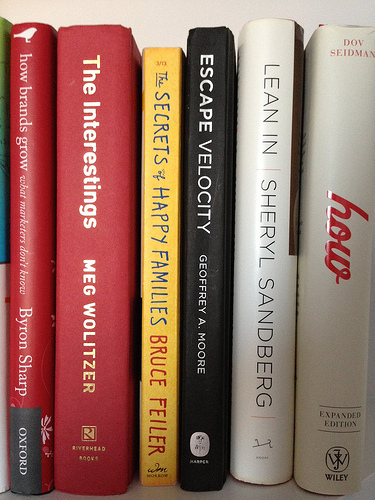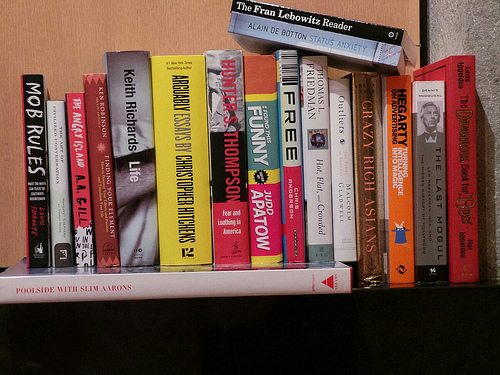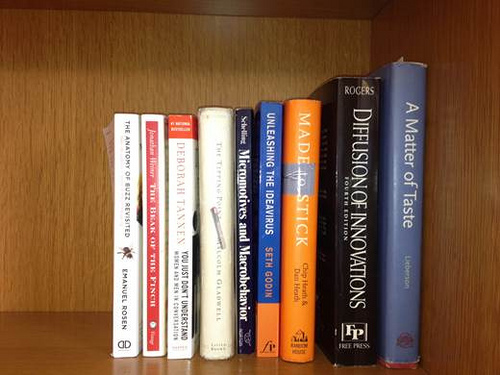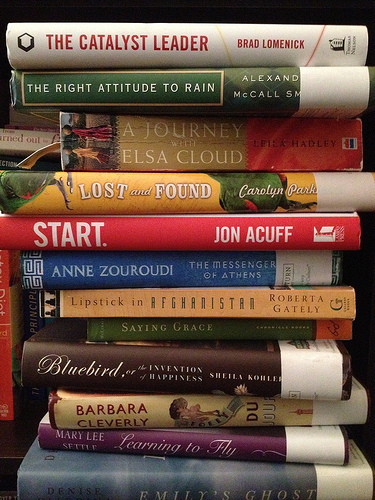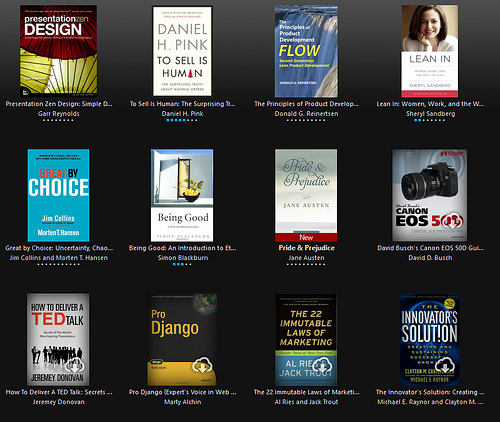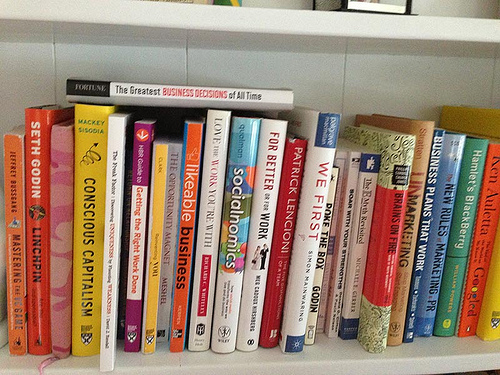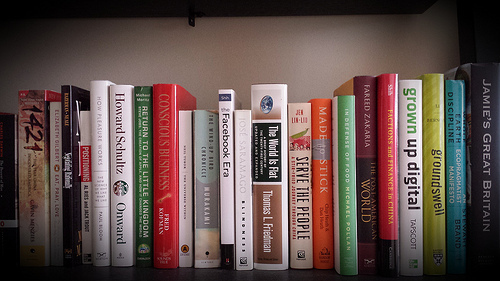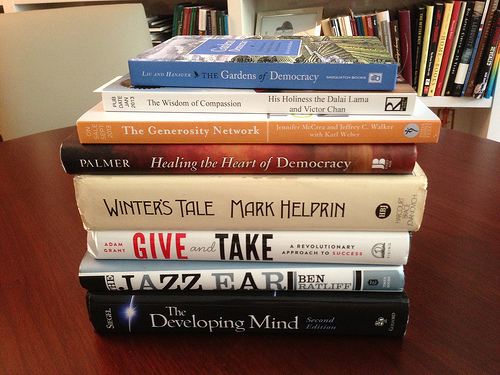Timothy Ferriss's Blog, page 108
October 28, 2013
How to Create a $4,000 Per Month Muse in 5 Days (Plus: How to Get Me As Your Mentor)

Photo: Stuck in Customs
Preface by Tim
This post is a follow-up to “How to Create a Million-Dollar Business This Weekend (Examples: AppSumo, Mint, Chihuahuas).”
The purpose of this guest post — written by Noah Kagan — is to show you exactly how a postal worker created a $4,000 per month muse. Included are all the tests, e-mail templates, and details you’d need to replicate his success.
Noah was employee #30 at Facebook, #4 at Mint, had previously worked for Intel (where he frequently took naps under his desk), and had turned down a six-figure offer from Yahoo. Since we first met, Noah’s helped create several multi-million dollar businesses, including AppSumo, loved by entrepreneurs everywhere.
For those interested in mentorship, don’t miss the end of this post.
There’s a time-sensitive chance to visit San Francisco for a week… to be mentored in-person by Noah and yours truly.
Enter Noah
The journey of Daniel Bliss is a telling one.
Our goal was to take his hobby — he was a full-time postal worker — and turn it into a real business making $4,000 a month so he could quit his day job.
We started working a few months before when he won the AppSumo Make a $1,000 a Month Business getaway to Austin to personally work with me for a week.
The preliminary call after Daniel won the getaway went well. Here’s what he told me:
He was solving his own problem. This is an easy way to figure out what business you should start.
Daniel’s a rock-climber and it hurt his neck to look up while he was belaying (standing on the ground helping the climber above him) so he wanted to buy glasses to make his neck hurt less.
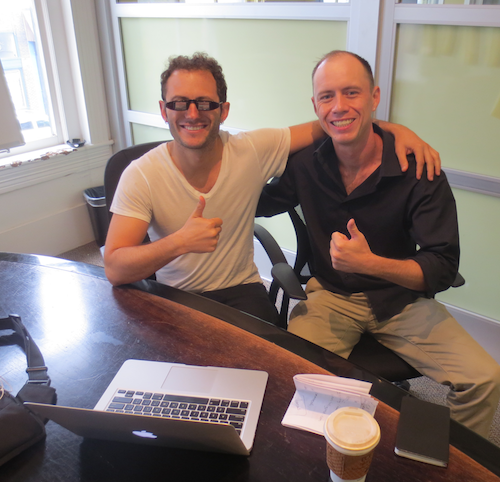
Here’s me with a pair of glasses on and Daniel.
All the glasses on the market were $99, so Daniel figured there had to be a way to make and sell cheaper glasses.
When we talked, he had already found a manufacturer through Alibaba.
Daniel first learned about using Alibaba to find a manufacturer in Tim Ferriss’s book The 4-Hour Workweek (page 175).
He searched suppliers on Alibaba and checked if they were a good fit by testing them on 3 characteristics:
1. How many years (if any) have they been considered a gold supplier?
Gold Supplier is a paid membership on Alibaba.com. All Gold Suppliers in China must pass an onsite check while those from other countries and regions must pass an A&V Check. Basically, this shows that they’re legit.
2. How is their website?
Poke around to see if anything seems shady. Do they have any negative reviews or positive ones? Search their name/email on Google and see what kind of results you get. This should give you a good feeling if they’re legit or not.
3. Is their “minimum order quantity” reasonable for what I’m trying to do?
You want to keep your costs down and not worry about selling hundreds of items. Daniel originally targeted 50 minimum pieces to validate his business without spending a lot of money.
Once Daniel narrowed down suppliers he ordered a few samples to test in person. He took these to his climbing group. Always look at who you have easy access to when selling your product. A common pitfall is for people to look at everyone outside their network and get rejected.
By himself, he sold 12 pairs. He sold 2 pairs to a couple he met while climbing and the rest to his climbing group.
So far, so good.
But then Daniel decided to spend valuable time creating a website: http://belayshades.com
How often have you bought a domain, imagining how large your new business is going to be? I KNOW you have. I have many times. You fantasize about how large your business is going to be instead of actually growing it. This is a common thing we help people with in our Make a $1,000 a Month business course.
Daniel’s been working as a postal carrier in Canada for 7 years, so expanding a business was foreign to him.
Daniel had gotten to the point where he was working without a goal so the first question I asked him was:
“To you, how much money is financial freedom?”
Once you know your destination, getting there is MUCH easier.
Tim’s written about figuring out your lifestyle costing, aka “financial freedom,” here: http://www.fourhourworkweek.com/blog/lifestyle-costing/
For Daniel it was $4k / month to be able to travel to Thailand and go climbing as he pleased.
Now it’s key to do the math to see how many pairs of glasses he’ll need to sell to get to that point.
$4,000 / profit a month
The glasses sell for $60 a pair with shipping
40% profit margins on every pair of glasses.
$60 * 40% = $24
$4000 / $24 (profit per sell) = 166 glasses a month.
Basically, 5-6 glasses a day.
That doesn’t sound so bad, right? When you take a goal and break it into daily targets, it makes the goal seem WAY easier and more digestible.
Competitors?
Before Daniel arrived to work with me, he started worrying about competition and patents.
BUT NO COMPETITOR CARES. Ever!
How many burger places are in your town? Cafes? Japanese restaurants?
Exactly, A TON. There’s enough for everyone and — fortunately for you — most people run their businesses like shit.
Worrying about others in the beginning is just a fear of starting.
Daniel’s focus on filing a patent was another aversion to starting.
The next week, he was worried about liability and everything except growing his business.
I’m not saying you should avoid setting up your corporation or take precautionary measures when it’s the right time. The key is to see what’s actually important for the time being and handling it.
Eventually, Daniel arrived in Austin and we had 5 days together to get his business to at least $4,000 in revenue. Here’s what went down:
Day 1 – Foundation
Now that Daniel knew his goal (sell 5-6 glasses a day) we used Quant Based Marketing to calculate how he could try various marketing tactics to grow his business and reach his goal.
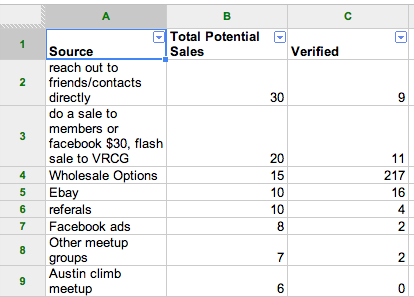
Example of Daniel’s Quant based sheet
See the actual marketing sheet here and feel free to use it for your own business.
What Daniel was previously doing for marketing was paying for Facebook likes and cold calling rock-climbing gyms to gain sales. It was going slowly.
The gyms said they needed time to see if they wanted to buy the glasses. When someone says they need time, it’s because you haven’t sold them properly.
For marketing, the key is to have a “lazy” mindset. With the quant sheet you can estimate the amount of sales you can get from all the different activities and then prioritize based on volume.
It’s critical to find the marketing activities that can scale and be repeated.
Daniel kept doing activities that weren’t producing, like submitting to PR Newswire. It’s not that it can’t work, but we wanted to get results faster.
So I asked Daniel, “If you could only use two of the marketing activities you’ve used before, what would they be?”
1. Personal network + referrals
2. Wholesale selling to climbing gyms / online stores
So we had our marketing sheet and planned to do 1-2 activities per day to see what worked best for his business.
Day 2 – Doing more of what works (personal network + wholesales)
Daniel searched Facebook for every single friend who listed climbing in their profiles and added them to a sheet.
Then Daniel individually messaged them. Yes, it’s work. To get The 4-Hour Workweek I’ve found it takes about 6 months of work to finally relax on substantial monthly income. [Note from Tim: This squares with reality; it usually takes 3-4 months to try enough that you can do a proper 80/20 analysis, then two months to design systems to scale what *is* working.]
Here’s the message Daniel used:
Hey
Hope you’ve been awesome.
I saw you like climbing. Me, too!
My neck always hurts when I belay, so I created super affordable belay goggles.
Have about 10 available. Are you interested?
Climb on,
Daniel
A few sales came just from messaging his Facebook friends. SCORE.
Then we created a list of every rock climbing store offline and online in Canada.
1. Search google for “rock climbing vancouver” or search “rock climbing” on Yelp
2A. Go to websites listed and get the owner’s name (if possible), email, and phone number. OR
2B. Hire someone on fiverr.com or craigslist to go through every listing and add them on a sheet for you like the one below (if you’re a lazy ass).

Daniel was already calling and emailing but not getting the volume of sales he needed from wholesalers and gyms. I asked to see what he emailed,. He showed me this:
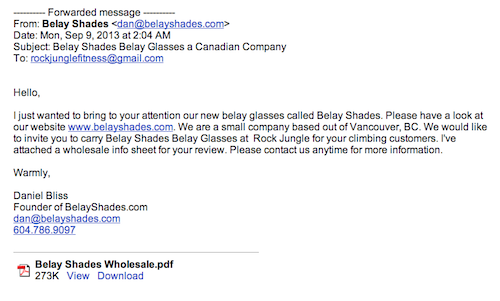
Damn, that is a bad e-mail!
Main things for you and Daniel to learn:
a) Getting a PDF from a random stranger is never something I want to open.
b) Make the subject line exciting to read.
c) Sales emails should ALWAYS be about the other person. Make it valuable for them so they want to reply.
d) Nobody’s name is Hello. “Hey ”. Work to find the first name.
Here’s an improved version that we worked on:
Subject: Helping you make an extra $1,000 at your climbing gym
Hey Colleen,
Hope things are amazing with you.
I’ve been working with climbing gyms like yours and wanted to hook up your members with my new belay glasses.
http://belayshades.com (people go nuts over them)
Was thinking, we can email your members with a special discount just for you and we split the profit evenly.
Be a great way for you to make a profit and hook up your members at the same time.
Can you let me know by this Friday if this sounds appealing to you?
Rock on,
Dan Bliss
And here’s the email for online retail stores:
Subject line: Best person to talk with for new climbing gear?
Hey John ,
Fan of your store and the fact your founder and I both do jewelry making

Noticed you didn’t have any belay glasses, which are becoming super popular with climbers.
Love to see if this makes sense for your store. Other climbing stores are seeing promising results with it.
How’s this Thursday 4pm CST for a quick 7-minute call to see if this makes sense for your store?
Belay on,
Daniel Bliss
To actually get a response, I had Daniel use what I call the quad-bomb:
1. Search their name on LinkedIn. Send them a connect request as a friend with a CUSTOM message. “Hey , Huge fan of your business and wanted to talk about some cool products for your customers.”
2. Email them.
I wait a day here as to NOT annoy them. If they don’t respond, then proceed to 3 and 4.
3. Facebook message them with: “Hey, just wanted to make sure my message got through”.
4. Tweet them. “Hey @twitter-handle. Love to see if we make some magic together. What’s best email for you?”
Why so many channels?
1. So many people are lazy and don’t put the effort in. You get out what you put in.
2. Sometimes people get busy, so your email may just get buried at the bottom of their inbox.
One of the key things that I drilled into Daniel’s head is to have a follow-up time with ANY person you are trying to work with. I use the line, “I have my calendar open, how’s X time to check in?”
Also I use followup.cc as a great free service to get reminders via email.
Rebuttal / sales sheets
Script out your answers to any possible questions during sales calls. This makes it easy to do your sales. This is also valuable so in the future you can have ANYONE do your sales a la The 4-Hour Workweek.
Here’s a sample of those sheets:
Rebuttals:
You guys are too small for us to work with
I feel we will work well together… we are small and you are big. Since we are small we can keep costs low and pass the savings on to you and your customers. Since you are large and have the reach for distributorship we can do business on a larger scale at smaller margins while still making a profit. Match made in heaven.
What about returns or defects?
We check each product by hand. If there is any problem, we stand 100% behind the product. We have a no-questions return policy for 30 days.
Can you guys do net-90 payment terms?
Yes, we can.
Where have you sold these glasses so far?
We are selling at local gyms and climbing groups all around Vancouver.
Can you give us a discount?
The price is the most affordable on the market. If you wanted to place a larger order, or can offer better payment terms, I’m happy to talk to my team to make it work for you.
Sales Questions to ask whosalers / stores / gyms
1. Something about themselves, a get-to-the-know-them question
2. What are your most popular items for climbers?
3. What are your favorite sites for finding out about new products? If tradeshows, which ones do you guys go to?
4. Do you guys already sell belay glasses?
5. How do you decide which products you want to sell?
6. [POTENTIAL TRANSITION] Well, it sounds like our glasses are right up your alley… (ONLY IF THEY ARE)
7. What’s your preferred amount for a starter order?
8. Is anything holding you back from placing an order of 30 with us today?
9. What are your preferred next steps to get this partnership rolling?
10. How’s x time for a check-in to make sure all is smooth?
Day 3 – Marketplaces + Groups + Advertising
Each day Daniel was in town, he allocated at least 3 hours to try a new method of marketing.
Who knows which will actually work? At the end of the week, we were going to re-evaluate and focus on the most effective ones.
Here are 3 marketing methods we tried out:
Posting on marketplaces
This involves posting your product to sites that already have your customers like eBay, Etsy, Craigslist or Amazon. All totally free, too. Done.

http://cgi.ebay.com/ws/eBayISAPI.dll?ViewItem&item=321233764523
Messaging on Meetup groups
Try messaging meetup groups to do giveaways. No responses? Oh well, move on.
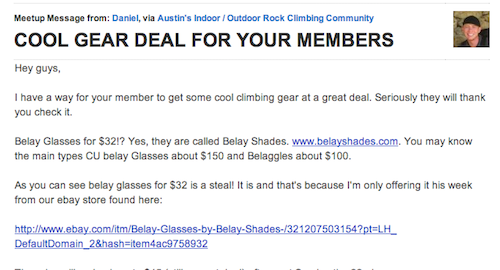
Facebook and Google Advertising
Here’s the exact FB ad we created:
Key things about this ad:
– Target audience is really small (24,000 people)
– Your target should be as NICHE as possible. The more unique — or direct the competitor — the better.
- Newsfeed ads have been performing STUPIDLY well for me, so we chose that route. But what works for me may not work for someone else.
- Limit yourself to your country and focus on just desktop computers, unless your page is very mobile friendly. Otherwise, you will waste a TON of money.
For Facebook ads, do NOT spend more than $10 a day while you are trying to figure out if you can make more than you spend from this marketing channel. DO NOT buy likes either — they are worthless. You have to rely on Facebook to communicate with your customers vs. having direct access. Get people to buy your product directly or give you an email.
Daniel tried Google Adwords with no success. Luckily, he used a free credit he got from starting a new account. You can get bonus AdWords credit via eBay.
Day 4 – Giveaways / Google / Random ideas
On Day 4, we continued trying new marketing techniques to find which would work:
Giveaways
Daniel reached out to various Facebook pages and bloggers related to climbing. Search Facebook for “rock climbing” or whatever your product is, and you should be able to find a few pages related to your audience.
Here’s what he would message them:
Subject: Free Belay Glasses for you and your
Hey ,
You guys look awesome! Glad to see the climbing community growing in .
Wanted to let you know about these cool new belay glasses for rock climbers http://www.belayshades.com
Love to send you a pair to try out. If you like them, I’ll happily give you guys a special price you can share with your members.
Easy enough, right? Just email me by with an address we can ship to, and we will send a pair out to you.
Belay on!
Daniel
This did not produce any results 
A better approach would be to mail out glasses to climbing writers and group owners and focus on building long-term relationships.
Google Top 20
If you were your own customer, what phrase would you search on Google?
For Daniel it was “belay glasses”.

In a non-spammy way, go through the first 2 pages of results on Google and leave a helpful comment or see if you can sponsor or get involved in that page. Way easier than trying to immediately rank for a keyword through SEO.
Daniel found a lot of forums and blog posts so he promoted himself on these pages. By looking at Google Analytics, we saw this drove a decent amount of traffic and sales to his website.
Posting on Reddit
There’s a decent amount of people in the /r/hiking or /r/climbing subreddits so posting a discount or asking for people’s feedback is a good test.
Daniel’s partner posted this thread and was able to sell a few glasses:

This sold 10 pairs, which is awesome for Daniel! But posting on Reddit and hoping to get responses isn’t predictable, and we want predictable. Can’t run off to Thailand unless you know cash is coming in consistently, right?
Updating his website
His site wasn’t bad, but he had a video that did not explain his product, as well as a random banner slide show that didn’t speak to visitors.
Before:

After:
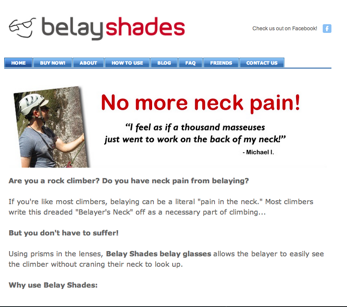
Day 5 – Bringing it all together
The key takeaway from the whole week: looking at what drove most sales so we can scale it up big time.
So from all the days activities, Day 2 seemed to be the most effective (reaching out to personal network and wholesale retailers).
Our goal for the five days was to grow Daniel’s business. By reaching out to his personal network and wholesale retailers and focusing what had already worked, we managed to make that happen.
Daniel got an email from a large online site named Sierra Trading saying they were interested in the glasses.
HOLY CRAP! He’d been waiting weeks to hear back from small local stores. Now an online provider is finally responding within a day. The store buyer originally responded via a Facebook message.
The order placed was for $4,200!!!!!
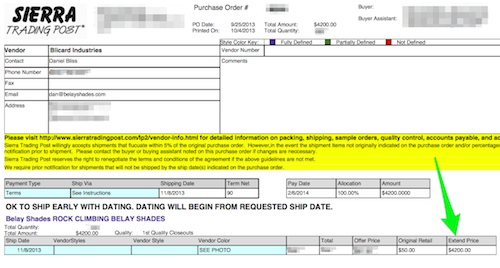
WAIT WHUH?!?!?!?!!!!
Lesson of the week: You never know what’s going to work when it comes to marketing. Try new things and then focus on what works until it stops working.

Daniel and the Amigos. Thanks to Anton + Robert for helping with this article.
Big thanks to HomeAway for sponsoring Daniel’s great loft in Austin, Texas.
A Week of Mentorship in San Francisco — An Opportunity
If you want help starting your own business, and if you’re a US resident age 18 or older, Tim and I have a special opportunity for you.
Take the following steps no later than 5pm PST on Wednesday, October 30th, 2013, and you could get an all-expenses-paid trip to San Francisco to work with us on starting your business.
Many surprises await the one lucky winner. Big time. Seriously.
Step 1 – Create a video (2 min or less) on YouTube explaining why you should be chosen. Start the video title with “Tim Mentorship” so we can find it.
Step 2 – Fill out this form. Be sure to include a link to your YouTube video (from Step 1) in the “Tacos or burritos?” answer! This is to ensure you know how to follow directions.
That’s it!

If you’re like Daniel and want the blueprint to start your own business, personal support, and access to a community of 3,000+ entrepreneurs, take a look at “How To Make A $1,000-A-Month Business.”






October 21, 2013
You Are What You Read: 14 Thought Leaders Share Their Bookshelves

Photo: Ozyman
The following is a guest post by Shane Snow, a frequent contributor to Wired and Fast Company. It includes photographs of some fun bookshelves, including yours truly (Tim Ferriss). CLICK ALL IMAGES TO ENLARGE.
Enter Shane
They say a person’s eyes are “the window to the soul.”
I am not very good at pupil-based soul-reading, but I’ve found that I can learn a lot about a person by the books on his or her shelf. When I go to someone’s house or office for the first time, my favorite thing to do is check out the bookshelf.
Here’s what’s on mine:

(click to enlarge any and all photos in this post)
Storytelling is a powerful force, as I’m a fan of reminding people. Stories—fiction and non—make ideas stick; they change minds and shape us in often subconscious ways. I believe the mind of a well-read person is heavily influenced by the books of her past.
A few weeks ago, I decided to conduct a little experiment.
I emailed a few friends and people I admired and asked them if I could see photographs of their bookshelves (or book stacks or Kindle screens). Just about everybody said, “yes.” The experiment soon metastasized, and I started pestering thought leaders in spaces I followed–tech, advertising, philanthropy–to see what books the innovators cared enough about to allot real estate.
Soon, I had more photos than I knew what to do with. Here are some of my favorites:
Hilary Mason, Chief Scientist at bit.ly and one of the smartest women in American tech
Fred Wilson, Partner at Union Square Ventures and the man responsible for investments in Tumblr, Etsy, CodeAcademy, KickStarter, Meetup, Soundcloud, Twitter, Behance, and StackExchange…
But I actually found this closeup in his Flickr photostream, too: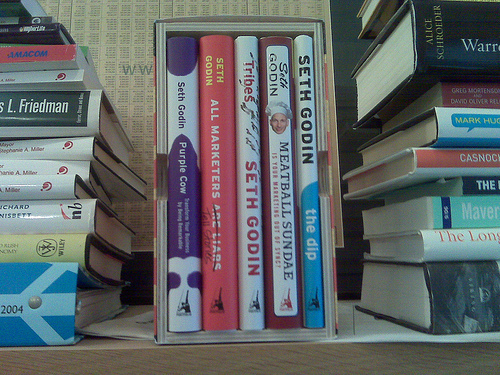
Guy Kawasaki, Bestselling Author of Enchantment, A.P.E., and a dozen other terrific books
Mike Lazerow, Founder of Buddy Media (sold to Salesforce last year for $700 million)
Mitch Kanner, Owner of 2Degrees and one of Ad Age’s “hottest rolodexes” in advertising (this guy hooks people like Jay-Z up with deals like Samsung’s million-album download)
Jonah Berger, Bestselling Author of Contagious and “virality” guru
Claire Ortiz-Diaz, head of Social Innovation at Twitter and one of Fast Company’s Most Creative People In Business
Dharmesh Shah, CTO of Hubspot and founder of OnStartups, and one of the most humble leaders you’ll ever meet
Dave Kerpen, Bestselling Author of Likeable Business and founder of Likeable Media (also the highest-trafficked LinkedIn Influencer in the world)
Cindy Gallop, renowned advertising executive and founder of IfWeRanTheWorld and MakeLoveNotPorn
Adam Grant, Bestselling Author of Give And Take and purveyor of revolutionary ideas about work and success
Clara Shih, CEO of Hearsay Social and board member of Starbucks (elected at age 29)
Jeffrey Walker, philanthropist and Chairman of JPMorgan Chase Foundation and author of the forthcoming book The Generosity Network
And I certainly couldn’t leave out Tim Ferriss, whose penchant for anime happens to be his secret weapon for language-mastery:
Interestingly enough, the book I referenced in the beginning about stories making ideas stick (Made To Stick by Chip and Dan Heath) shows up several times in this gallery. There are a few other repeats if you look carefully!
Of course, there were a number of well-read people whose bookshelves I’d love to get a peek at (but unfortunately couldn’t get a hold of). In particular, I wish I could check out the shelves belonging to the following five:
Arianna Huffington
Elon Musk
Martha Stewart
Joss Whedon
Cory Booker (and not just because of the name!)
We’re all a product to some degree of the books we read, the programs we watch, and the people we meet. In the comments, I’d love to discuss: What books from this gallery jumped out at you? Whose bookshelves above do you identify with in particular?
And, perhaps most importantly, what are the most important 2-3 books on your bookshelf?






October 13, 2013
Announcing: “The Tim Ferriss Experiment” on Primetime TV (And How to Join Me)

After ages of planning, I’m VERY excited to share big news with you all.
Starting this December 1st, I will have my own primetime TV show, airing Sundays at 8pm on HLN, formerly known as CNN Headline News. I’m both host and co-executive producer, and I’m currently filming my ass off. It’s all part of a big Turner Broadcasting initiative called Upwave.
Here are the basics:
Name of show: The Tim Ferriss Experiment (TFX)
The premise: Showing viewers how to become superhuman through better tools and tricks, not better genetics.
Easily thought of as: “Anthony Bourdain meets Jason Bourne” or “Jackass meets A Beautiful Mind”
Production company: Zero Point Zero (ZPZ), the team behind Anthony Bourdain’s No Reservations and Parts Unknown.
Spirit animal: Ocelot.
Synopsis:
In his #1 bestsellers, “The 4-Hour Workweek,” “The 4-Hour Body” and “The 4-Hour Chef,” Tim Ferriss proposes radically counter-intuitive solutions that take readers from zero to hero in minimal time.
Newsweek calls him “the world’s best human guinea pig,” as he tests the extremes for the rest of us. He believes that nearly any skill can be “hacked” and learned in 1/100th the time most people expect… but can he do it in a matter of days?
The Tim Ferriss Experiment (TFX) will push Ferriss to the breaking point as he attempts just that.
In each episode, Tim will find the world’s most unorthodox teachers and – together — demystify some of the world’s coolest and most dangerous skills. Sometimes he’ll succeed, and other times, he’ll fail spectacularly while risking life and limb.
Tim believes that there is the potential for greatness in every “normal” person, and as he overcomes his own fears each week, he’ll help viewers do the same.
[TIM NOTE: Sorry I can't share exact episodes yet, but just imagine Jason Bourne + my biggest fears + my personal bucket list, all wrapped into one. What would *you* like to see me tackle? Please let me know in the comments, as we still have a few open slots!]
How You Can Join Me
Would you like to join me for a week? Here is one opportunity, which expires tonight (Sorry!) at midnight: Swim with Tim. There will be more fun opportunities if you miss this one.
Next: would you like to interview me about TFX for your TV show, magazine, radio program, podcast, blog, e-mail newsletter, or other? It would mean the world to me, and I have plenty of insider stories and takeaways. If interested in discussing options, please fill out this short form here.
More details coming soon!
Thank you all so much for your support. It’s what keeps me going.






September 29, 2013
Marc Ecko’s 10 Rules for Getting “Influencer” Attention
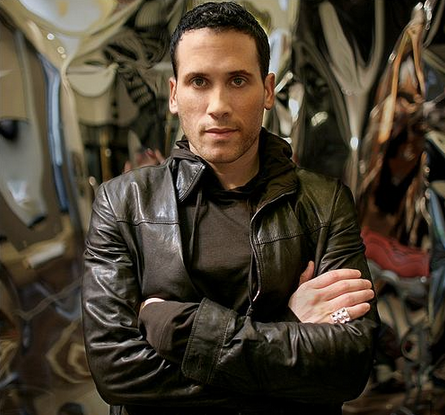
The dream is simple: get your product in the hands of celebrities or “influencers,” and they create a ripple effect that skyrockets you to fame and fortune.
What if Kim Kardashian tweets about you?
What if Hugh Jackman wears your custom shirts on the red carpet?
What if a top blogger includes you in a top-10 list?
What if you got a mention on The Office or another primetime show?
Sadly, sampling to “stars” seldom works out.
People who move the needle get a TON of stuff sent to them. The pic below is just part of my mail, and I’m not even a real celeb! Blurb and blog promotion requests received in one day, with the exception of one book:
So…how do YOU break through the noise?
This guest post will teach you. It’s written by Marc Ecko, founder of Marc Ecko Enterprises, a global fashion and lifestyle company. I wanted Marc to write this post because — in my opinion — he’s an expert at selling yourself without selling out. As CNBC put it, “Marc is living proof that you can be a marketing and business whiz and still be a true artist.”
Once a graffiti artist with no connections, Marc left the safety net of pharmacy school to start his own clothing company. Using hustle and creativity, he turned a $5,000 bag of cash into a global corporation worth hundreds of millions of dollars.
He created a lot of this success by repeatedly getting his products to impossible-to-reach icons (e.g. Spike Lee, Chuck D) and planning elaborate PR stunts (e.g. Air Force One graffiti hoax; buying Barry Bonds’ homerun record baseball and letting online votes determine its fate).
This post will explain his 10 rules — the do’s and don’ts — of his unique “swag bomb” approach to getting influencer attention. I agree with all of them.
Enjoy, replicate, and prosper…
ALSO: Marc will be answering questions in the comments, so leave your thoughts after the end of this post!
Enter Marc Ecko
Before Ecko was Ecko, it was just me, a suburban kid in New Jersey airbrushing stuff in my parents garage. In terms of hip hop, I was the quintessential outsider. I didn’t know anyone, I didn’t have any connections. All I knew was that I was passionate about my art, and that I wanted to make a business out of it.
In other words, I was in the exact position that basically every entrepreneur, author, and creative person in the world starts in. I had to make a name for myself–I had to crack in. I could only think of one way: giving stuff away for free to people who would like it. Taking action.
Over the years I perfected this strategy, using it to launch and build countless brands from Ecko Unltd to G Unit to Cut & Sew, Complex and Zoo York. Ecko, alone, has done billions of dollars in revenue since those days in the garage twenty years ago. Our collaboration with George Lucas and the iconic Star Wars brand was a direct result of this strategy. I’ll go to my grave proud of the fact that George Lucas actually said–and this is a quote–“No one has made STAR WARS cooler than ECKO.”
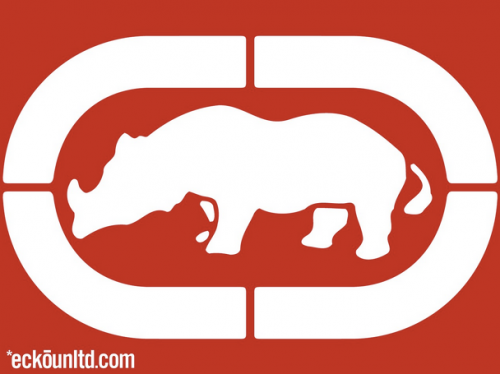
A lot of people think that mailing samples is just that–throwing some crap in the mail and hope it works. Well, that couldn’t be more wrong. A Swag Bomb, properly executed, is a work of art. When done right can generate massive amounts of PR, connections and access.
When done improperly, it ends up here…in the pile of orphan books at the New York Times. Or worse, it ends up in the trash can or lays their unopened. You’ve worked too hard to let that happen, to throw that work away because you made some simple mistakes.
So let’s go back to that garage. I’ll show you how swag bombs were instrumental in building the Ecko brand and then the lessons I’ve learned–trust me, I made a lot of mistakes–along the way.
The first person I ever tried to send one to was Kool DJ Red Alert. Back then he was one of, if not the, most dominant DJs in hip-hop, and Rolling Stone magazine would name him as one of the fifty most influential people in music. Every weekend night, in an era before iTunes and Spotify, everyone listened to Red Alert on the New York radio station 98.7 Kiss-FM, the audio bible of hip-hop.
I couldn’t wait until his Friday-night show. Red was famous for doing shout- outs. I had no patience for waiting on hold and doing the dial-up thing, so I went to my strong suit of communication: my art. During his radio show, I camped out at the Kinko’s and straight-up spammed his fax machine with “Echo Airbrushing” promos. Black-and-white pen-and-ink illustrations of MCs standing encircled in a rap cypher. Or images shot from the floor to the sky, showing MCs jumping across the stage. All the images were unapologetically self-promotion- al—self-referential—and clearly branded and signed “Echo.” (I actually have a photo of one of the hats still–check it out)
And then one Friday night I’m listening to 98.7 like always, drawing in my black book, and I hear something on the radio.
“I gotta shout out my man Echo for blessing me with this fly gear! Yo, he got the fresh airbrushed gear, the craze snapback hats! My man Echo Airbrushing, yeah, yeah, Big Up Lakewood, New Jersey, and my man Echo, artwork is crazy.”
Whoa, what!?
The shout-out tasted good. I wanted more. I didn’t get complacent and didn’t let it fizzle as a one-shot thing; I had an instinctive grasp of the power of inertia, so I doubled down and sent him more.
I knew that I was on the verge of something. I knew because it felt authentic. I could sense that the timing was right and that I needed to take it to the next level.
I hope these rules–many of which I learned the hard way–will help you do the same with your own efforts.
===
TEN RULES FOR BUILDING A SWAG BOMB
1. Never Send Directly to Someone’s Home
I’ve had that happen. It’s fucking creepy. Everyone has a business address, and in this day and age, they’re sufficiently accessible. No one likes to feel like you’ve violated their personal space–and if you do that, that negative feeling is associated with your product, thus defeating the purpose.
Even creepier? Sending actual bombs. Look, I know it is a “swag bomb”, but there is no swag in sending unsolicited items to a personal address, particularly when the items are disguised to look like explosives.
For example, if you’re sending out a book (as I did; more on this shortly), don’t send them to reporter’s homes. That would be creepy. I sent mine to their office address, through my publisher, like normal people would do.
The same goes for email addresses. Don’t find every single email address the person has ever listed and blast them all at once. Don’t scour for the “private” or “personal” email because you think they don’t check the main one listed on their contact form. It makes you seem desperate–and weird. Find their public email and make your pitch. If you do it well, it will work. If it doesn’t, the problem is your pitch…not where you’re pitching it.
2. Never Expect Your Intended Audience to Even See It
So make it good enough that even if it gets to only his or her lieutenant—which will often be the case—you still make a material impact. In other words, if you’re in the t-shirt business, don’t send one shirt. Send an enormous box fill. Make the delivery a big event.
My friend Ryan Holiday did the marketing for American Apparel and instead of sending some small package, he sent a crate. One of the bloggers uploaded a video on YouTube and it did 125,000 views. That’s crazy. Look at Pepperidge Farms, which overnighted a box of “Milano” cookies to a blogger who wrote about the cookie. The act was memorable enough that the resulting post on reddit scored Pepperidge Farms over 500,000 new views and fans. But even if that had never gone public, it was still a cool way to hook a fan up–and all they would have been out was a couple bucks.
Me, I seeded my brand with the bona fide artists and instigators of pop culture. The motivation wasn’t as simple as “I hope they wear this”; it came from a desire to educate them, to land on their aesthetic radar, and to build a literacy of who I was and what I was trying to accomplish. So even if the package doesn’t go all the way to the top, it’s still making waves where it matters.
3. Never Send Just the Stock Shit
Think deeply about what you will send them, and work hard at customizing the content so that the end user will recognize this as an amazing, highly personalized gift. And it’s just that—a gift—so…never have expectations beyond giving a gift.
Back in the day, I could quote Do the Right Thing and Mo’ Better Blues backward and forward, so I sent Spike Lee some gear too. I heard he had a new movie out—a biopic of Malcolm X—so I sent him a sweatshirt with a meticulously painted portrait of Malcolm X on it. Personalization is crucial. I must have spent two days on that one.
Spike Lee graciously sent me a thank-you note—an actual signed letter from Spike! Fucking! Lee!—and that felt good. “Ya-dig? Sho-nuff.”
Take HBO sending custom bags to promote premiere of “Liberace”. They featured items tying into the biopic of excess living and luxury to relevant journalists. Custom Moet & Chandon bottle, engraved necklaces, the works. They went crazy over the top because that’s Liberace. Something stock wouldn’t have made any sense.
Another fun bit of inspiration. Remember Woot.com’s “bag of crap” deal? The reason it was so fun? Every once in awhile somebody’s bag would be full of cash. You can bet the internet blew up every time that happened. You can create that reaction with your own products too. You can blow people’s minds with a surprise every now and then.
4. Never Have Expectations, as It’s Just a Gift
The joy and purpose has to come from the confidence that you did it; you took action. Not everyone will acknowledge receipt. That’s okay. The point is the send out a lot of these–eventually you’ll get one or two big connections that subsidize all the misses. After all, I didn’t just send to Red Alert, but also Public Enemy’s Chuck D. Q-Tip. KRS-ONE. Essentially, I sent packages to all the cultural pioneers who inspired me.
For my book Unlabel, I hand-packed 15 Ecko-branded white shopping bags with red paper inside. Inside each was a big white Ecko branded watch, an Ecko fragrance, the super sweet wireless speaker that looks like a black spray paint can, plus Ecko earbuds. The reporters I sent them to were likely expecting a t-shirt (or just a book in a plain envelope and instead got a Swag Bomb that said Ecko was much more than that. Even though we invested a couple hundred dollars in the package, I’m not going to be upset if they don’t write about it.
A swag bomb is not a contract, there are no guarantees. Even when it is a $50,000 swag bag at the Oscars. It’s all about the hope that if you send the right stuff and hit the right chord, magic will happen.
5. Never Handwrite Your Marketing Materials
It’s one thing to send a handwritten cover note (preferably a 6” x 4.5” stock postcard) that’s less than twenty words. Fine. But it’s something else to send an all-handwritten business proposal that looks like it came from Son of Sam. I don’t care how legible your writing is. Type.
Don’t think of this as sending “fan mail.” This is a professionally produced, hyper-customized presentation. When you send me (or anyone) a solicitation of your idea, or your product, or the marketing materials of who you are and what you’re trying to sell, work backward from the experience of cracking open the box from its taped seal.
6. Never Use Second-Hand Packaging Materials
A used Trapper Keeper folder— with maybe a sticker over the dents so that you pass it off as new—ain’t cutting it. Why should I take your idea seriously if you’re not even willing to make a quick trip to Staples? Presentation is everything.
For example, early on I helped my best friend Cale (an aspiring R&B singer) get a meeting with Michael Bivins (Biv) with one of my jackets. Biv, a member of New Edition and Bell Biv Devoe, was the Simon Cowell of early-1990s R&B; he had a knack for discovering young talent, taking chances, and making stars out of nobodies like three Philly kids who became Boyz II Men.
We went all out. I made the jacket in the Blue Room of my garage, using a canvas of Swarovski crystals I had copped from a rummage store. Black, pewter, red, and clear. I bedazzled the hell out of that thing, one crystal at a time. Then, I tucked the cassette of my best friend Cale, along with a note, in the left chest pocket. That’s what we really wanted him to see.
Same goes if you’re more established–don’t just have the warehouse or your manufacturer (or Amazon.com) send some package on your behalf. Be legit, handle it like it’s a work of art. Someone complained to Old Spice recently, so they unsolicitedly hooked the guy up. But look how professional it looks–it wasn’t a couple sticks of deodorant in a box. It looks legit–like they actually care.
7. Never Stalk
If you have a phone number or email of an executive assistant, fine, it’s okay to call once in advance and then again once in confirmation of receipt. (You can also send it with a certified receipt, so you know who signed for it, and when.) But don’t call repeatedly like some psycho. Not cool.
Look at all the gift bags they give out at SXSW each year. Can you imagine if taking one was an implicit contract with the companies to follow you on social media or beg you for favors? It’d be a nightmare. People would be afraid that taking a t-shirt was akin to signing your life away.
Treat handlers (assistant, publicist, manager, associate) with respect. Not only is this the right thing to do, but this could be the hand of the king—and they’ll later whisper into the king’s ear.
In fact, after you confirm the receipt, consider the ball to be in their court. Don’t do anything until they make the next move. Got it?
8. Never Forget to Include Your Name, Email, and Phone Number
Don’t presume that anyone is going to read a long letter. If the visual impact and the overall wraparound isn’t there, you’re dead. So make sure it looks good, feels good, and that it emotes your goals. And make it as clear as the sun who sent it. God-forbid you make a connection and then they don’t know what to do about it.
After we gave the jacket to Biv, we sat on pins and needles waiting. At three o’clock in the morning, the phone rang.
“Yo, is this Marc? This is Biv.” Biv’s signature gravelly voice.
“Hi, um, yeah, this is . . .” I tried to remember my name.
“I want to hook up with your man Cale. Tell him to be at the Sheraton in Red Bank in thirty minutes.”
Three thirty am. Cale didn’t chicken out. Cale jumped on a once-in-a-lifetime opportunity. Cale took action. Two weeks later, Biv signed Cale to his newly formed imprint on Motown Records called Biv 10 Records.
When you get, The Call, be ready to go. No matter the time of day.
9. Never Send a Picture of Yourself Fan-Boying Out
Again, creepy. Let the content and the high concept speak for you. Don’t send some weird headshot.
Don’t be the guys and girls in these photos. Don’t! Look how miserable (but patient) the celebs are. But that would immediately stop if the people followed up with “Now let me tell you about my awesome business idea.” That chance was blown.
If there ever was someone to fanboy over in my personal life, it was George Lucas. However, instead of sending strange photos of my star wars collection, I waited until I was near Lucas, and casually showed him my geeked-out Yoda BlackBerry case I had personally made, and we instantly had a good vibe. There is a time and place for fanboy-dom, and pre-pitch isn’t it. (Here I am with George–see how calm I am being? It was hard but I made it.)
10. Never Gush
Notable figures don’t like being fawned over. Be careful to whom you say—and how often you say— “I love you.” (Good rule for life in general.) Don’t tell them, “You are my idol.” Speak matter-of-factly, and acknowledge the traits or practices that you respect and admire.
When Barry Sanders scored a touchdown, he would casually toss the football back to the ref, shrugging, and living by the credo “Act like you’ve been there before.” That should be you.
Leave the gushing to them. After all, if you do it right, they’ll be so grateful or impressed by the gift that they’ll give you the treatment.
CONCLUSION
There is one reality every entrepreneur has to face. You’re always pitching. You never stop auditioning. Even for Spike, even Mark Zuckerberg, even for the president.
The Swag Bomb is part of that. Get your stuff–because it’s great–in the hands of as many important people as you can. Sweat and bleed and innovate to make that happen.
An authentic personal brand is more than just an idea. It’s not static. It’s not enough to say I have a brilliant idea and then lock it in your laptop. And it’s not enough to just talk about it, tweet about it, blog about it. Talk is cheap. An authentic, unique voice is a doer.
You will always keep pitching, and you will always have to deal with rejections. This doesn’t mean you should give up; it means you’re human and you have a pulse.
It’s tough to find famous examples of companies, artists, or individuals who didn’t get there in some way with excellent presentation and artistry in bringing in important early influencers and adopts.
The more telling example is the thousands of companies and millions of people you haven’t heard of: the artists, entrepreneurs, creators, and would-be instigators who talked a good game but never put themselves or there or did the work to get noticed.
Afterword by Tim
The “Swag Bomb” approach has many applications. Instead of customization, you can choose a unique venue, as I did when I gave away 500+ copies of The 4-Hour Chef at a TechCrunch Disrupt event, knowing that bloggers and other media would be there. It was unexpected, and the copies disappeared within hours, leading to tons of social media chatter when it mattered (during launch).
Last but not least, it often pays to NOT go for the most popular celebs, Twitter accounts, or otherwise. Remember the bar scene in A Beautiful Mind? On a 1-10 scale, 10 being the most trafficked, three or four 7 bloggers featuring you is far better — and easier/faster to achieve — than you obsessing over landing one 10 blogger.
For more tips and tricks for how to jump from niche to mega-mainstream, I highly recommend you check out Marc’s first book, Unlabel: Selling You Without Selling Out.
Marc will also be answering questions in the comments, so please share your questions below! If you have any sample-sending success stories of your own, I’d love to hear them.






September 23, 2013
You’d Like to Be an Angel Investor? Here’s How You Can Invest In My Deals…
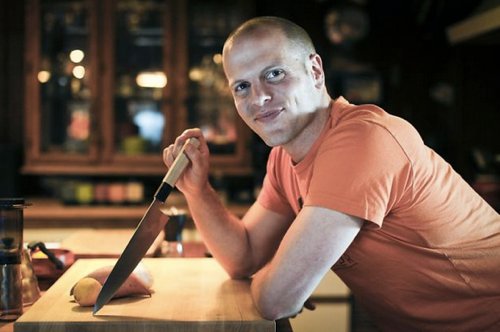
Most deals get done in informal settings. Now, I’m inviting you to join me. (Photo: Russell Yip)
Please note that my syndicate investing in Shyp has now closed. You can still back me on AngelList to gain priority access to future deals. More updates will be posted here later in the round.
On September 23, 2013 (that’s today), the world of startup financing changes forever. It’s a truly historic moment.
Previously, I couldn’t publicly share deals with you. Now, thanks to an unprecedented legal change, I can offer a portion of my start-up investments to any of you who qualify as “accredited investors.”
Previously, you had to be part of a small club to see such deals. Not any more.
Previously, you might even need to be in Silicon Valley, drinking wine and having coffees around the clock, to see good deals before they filled up. No longer.
Starting today, I’ll share some of my favorite deals with you, beginning with a start-up called Shyp.
Notable companies I’ve advised include Uber (pre-Series-A), Evernote, Automattic (WordPress.com), Shopify, and TaskRabbit, among others. Early investments include Twitter, Facebook, Reputation.com, etc.
In this case, I used a “Spearhead Capital” blog post to my ~1.4M monthly blog readers to find promising startups. Nearly 400 companies applied, many of which are producing millions in revenue. Out of all of them, and with the help of Naval Ravikant (CEO/co-founder of AngelList) to interview finalists, I chose Shyp.
Shyp is the fastest and easiest way to ship packages. More on that shortly.
Investing alongside me–and potentially you–in this round are:
David Marcus (President of PayPal)
Brian McClendon (Founder of Google Earth)
Daymond John (Founder of FUBU, Shark on ABC’s “Shark Tank”)
Joshua Schachter (Founder of Delicious, Tasty Labs)
Aaron Batalion (Co-founder of LivingSocial)
Homebrew (Hunter Walk and Satya Patel)
Naval Ravikant (CEO/co-founder of AngelList)
Scott Belsky (Founder and CEO of Behance)
Sherpa Ventures (Scott Stanford & Shervin Pishevar)
Antonio J. Gracias (Board Member at Tesla and SolarCity)
XG Ventures (Andrea Zurek and Pietro Dova)
Osama Bedier (Former head of Google Wallet)
…and more
So, how can you join us?
Before I tell you, remember:
Startups are speculative, and this is gambling. You shouldn’t invest anything you’re not comfortable kissing goodbye. Treat it as casino money.
If you are going to invest in startups despite this high risk, plan on building a portfolio of dozens, very slowly and carefully. This should be just one of many. Read more on approach here.
The Short Version
If you’d like to invest in Shyp, simply click here. A description of the company is in “The Longer Version” below.
You’ll need to set up an AngelList profile (free), and the minimum investment is $2,500. We’re only able to accept $250,000 from everyone.
For more on the team and concept of Shyp, click here.
If you miss this one, not to worry–you can automatically join my deals in the future, which puts you first in line next time.
Can’t invest right now? No worries. If relevant, I’d love for your to consider any of the below actions. Shyp and I would really appreciate it!
- Apply to be a Shyp Hero (Heroes are Shyp’s drivers). Click here.
- Apply for a job on Shyp’s core team. Click here.
- Interview the co-founders of Shyp: Kevin, Josh, and Jack. They’re clever gents. Just email: founders at shyp dot com.
- Tell Shyp which city you live in so they can launch there before others!
The Longer Version
I’m putting my name and network behind Shyp and personally investing $25,000. I’ll also be providing oversight and advising the company on product/conversion optimization, national launch strategy, etc.
I’m using a new AngelList feature called “Syndicates” to share my $250,000 allocation of Shyp.
Unlike venture capitalists (VCs), I am charging zero management fees. If you don’t win, I don’t make a dime. If you invest alongside me, the only expense is a 20% “carry” (roughly 20% of the profits) if there’s a good outcome.
DESCRIPTION OF SHYP
Shyp is the fastest and easiest way to ship packages.
Through the Shyp iPhone app, you take a photo of what you want to send, specifying destination and pick-up time. You’re done.
A “Shyp Hero” (driver) arrives at your home or office at the specified time, takes your unpackaged item away to be packaged, then sends it on its way via the optimal carrier (i.e., Fedex, UPS, etc.). Shyp automatically optimizes for speed and cost, and Shyp charges no more than Post Office prices, plus a $5 pickup fee for sending solo items. If you send more than one item, the company waives the $5 pickup fee.
More on how this works below the video.
I have confidence in the team, and here’s why I love the model:
- Recurring revenue. It has a frequent use case, just like Uber and Evernote (again, both of which I’ve advised). Millions of people can use Shyp on a weekly or daily basis.
- It’s simple and solves a real problem. Do you enjoy going to the post office or UPS store? Scheduling pickups that require you to be available for 3-6 hours? Of course not. Shyp makes fixing all that as easy as snapping a picture. And they package everything for you. No more wasted afternoons.
- It has unusually high margins. Shyp matches USPS retail prices, but by taking a volume discount from carriers and utilizing regional couriers (that end-users cannot), Shyp can maintain high profit margins. Using OnTrac, as one example, is 75% cheaper than USPS.
- It’s tackling the “first mile” problem, not the “last mile” problem. Lots of companies are focused on same-day delivery from retailers to consumers: the last mile. It’s a crowded battlefield of a market. But what about the burden of packaging up shipments from homes and offices? This “first mile” problem is enormous, and the market is neglected. Shyp aims to own it.
How to Get In First
Would you like first access to my future deals, right alongside my close friends?
To see things before I post them on the blog, you can automatically back me on AngelList, as Naval (CEO of AngelList) and others are doing. Click here for more details. This will ensure you don’t miss anything.
###
DISCLAIMERS — DON’T SKIP:
Startups make big plans a lot, and most don’t follow them. Shyp might run out of money; customers might not like using a third party to ship things; UPS, Fedex, or some upstart could start competing; or the team could simply fall apart tomorrow. Any statements about their future plans, margins, etc., are pure speculation on my part. That’s why startup investing is very risky, so again: don’t invest anything you aren’t prepared to write off 100%. Last but not least, I’m not necessarily planning on sending frequent updates or notices of Shyp’s change in plans (if any), as startups change on a weekly or daily basis.






September 17, 2013
How to Get National Press With No Budget (Plus: One Year of Mentorship from Alexis Ohanian)
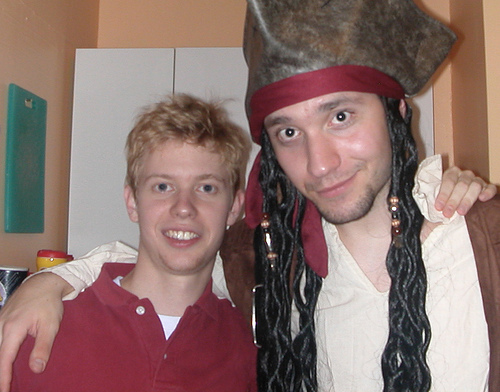
Preface from Tim
This is the second post by Alexis Ohanian for Entrepreneurship Week on this blog. Here is the first post, which covers his founding of reddit, which he later sold for millions of dollars.
This post covers a critical topic: how to get massive attention for your company from national media. How do you pitch press? Develop relationships with influential journalists? The real answers might surprise you.
Most books and articles on this subject are pure BS. Speaking as someone who’s been on magazine covers (Outside, Inc. Magazine) and section covers (NYT Style Section, Travel Section), I can tell you: there is a science to this.
Alexis is a master. Enjoy.
Enter Alexis
I’m back!
Tim very kindly invited me back to give you another excerpt from my book that draws from all my experience over six years as a Y Combinator advisor and startup investor (70+ companies).
I want to help you do what Steve and I did (not in costume) to grow reddit into the top-50 website it is today… with a total advertising budget of a few hundred dollars. I spent that all on stickers…
Sidenote: The first one of you who tweets at me (@alexisohanian) with the correct answer for Steve’s Halloween costume in the above photo will get a signed copy of Without Their Permission, plus some fun extras.
Traction: Everyone wants it, here’s how I think about generating “buzz”
I’m not a businessman, I’m a business, man.
—Jay-Z, “Diamonds From Sierra Leone”
I believe in startup karma.
Being the kind of person who’s always asking for favors and hustling others is a reputation that not only gets around, it sticks. It’ll work in the short term, and perhaps there are some exceptions to the rule who have made it work in the long term, but being someone who’s always asking for favors makes the already difficult job of starting something new immeasurably harder.
Instead, look at every meeting as a chance to do someone a solid. This especially matters when dealing with representatives of the media, because just buying them a coffee doesn’t mean you’re getting a front-page story. Look at every meeting as a long-term investment. She’s not writing about your startup? That’s okay!
Be helpful. What’s she thinking about right now? Some kind of trend is going on in X that’s not been covered yet, and she’s looking for a founder doing Y. If you can connect the dots, make the introduction for her. You’ve just helped two people with one e-mail. Cha-ching. More good karma.
Over the years, you can build a reputation as a connector in your field. Connectors are a journalist’s trump card when they need to get a lead on an unreported idea, or when they need an introduction in order to land a useful interview. This is a valuable position for you to be in, because it means you’re going to stay at the tops of their minds. When your journalist friends are writing about something in your field, whom do you think they’re going to reach out to first?
Never Turn Down Cannoli
In between bites of cannolo (yep, that’s the singular form of cannoli), I was explaining to Rachel Metz, freelance reporter for Wired, why reddit.com was going to become the front page of the Internet. She seemed interested, but she could’ve just been enjoying her cannolo.
I’d taken the Fung Wah bus down from Boston to meet with her in downtown Manhattan because a few weeks earlier, I’d met a friend of hers named Jennifer 8. Lee. Jenny had attended a Halloween party that Steve and I had thrown at our Somerville home and office—which should explain the above photo—and we hit it off. We discussed the subject of her book proposal, which happened to be, of all things, Chinese food. I managed to impress Jenny with my knowledge of Chinese cuisine, so we got to talking that night and that led to her introduction to Rachel.
A few days later, Rachel would confess to me that while she initially wanted to write a story about reddit, she felt we’d become friends and that it wouldn’t be professional for her to pursue the story. That was fine by me. No Wired story came from that, but I got a new friend in Rachel, one who happened to mention reddit to her editor at Wired, Kristen Philipkoski. Kristen, the wife of Kourosh Karimkhany, was doing business development for Conde Nast and heard from Rachel about a pair of plucky founders in Boston working on something interesting called reddit.
And then one day (February 22, 2006, to be precise) this e-mail popped up in my inbox:
I’m a friend of Rachel Metz. I’m also the director of biz dev for CondéNet, the internet arm of Condé Nast, which, as I’m sure you know, publishes magazines like Wired, GQ, Vogue, New Yorker, Vanity Fair, etc. I’m intrigued with your technology and was hoping to set up a time to talk about possibly working together. I’m open the rest of the day today and Thursday, but will be traveling for a week starting Friday. Do you have time for a phone call? Also, are you based in Boston?
Little did we know that exactly one year after that fateful party on Halloween, Steve and I would be celebrating the acquisition of our company. As if you needed more reasons to throw a Halloween party. Or eat cannoli.
Everyone Is the Media
The traditional public-relations industry model is broken. Good riddance.
The only time I ever wrote a press release was when Condé Nast made me do it for the announcement of our acquisition, and I wasn’t about to argue with the company that had just bought my company. Full-disclosure: Since writing this book, I’ve had to edit a press release the PR firm hired by my publisher wrote on my behalf. But the truth is, I’m not certain that press releases are as relevant as they were in the twentieth century.
These days, everyone you meet is part of the media. Every relationship you enter into, whether it’s with a customer or a writer at The Wall Street Journal, is a long-term investment. No self-respecting journalist wants to feel like all she does is publish press releases as “news,” although some do. The idea that a press release is magically going to compel someone to talk about what you’re working on is absurd. At a time when none of us have enough time to pay attention to all the content the Internet produces, you can be sure the professionals who are pitched every minute of the day certainly don’t have the spare cycles. This means you’re going to have to make yourself known. Here are some things to keep in mind as you do that.
Be Helpful
If you’ve been doing your job as a founder, by now you should be an expert in your industry (and maybe even in a few others as well). Use that to your advantage when talking to the media. It gives you insights on bigger trends that are valuable to journalists, so be helpful—even if it’s not directly helping you or your company, it is actually still helping you and your company. Anything you can do to help someone else do his or her job better is going to win you that valuable startup karma. Noticing a trend in X meets Y, offer an introduction to some other experts in X meets Y. Be helpful!
Remember the RentHop team from chapter 4?1 While Lee Lin was getting his broker’s license, he found himself noticing trends. He validated that hunch when he and his co-founder, Lawrence Zhou, started mining mountains of New York rental-price data that revealed everything from how much more people are willing to pay for a doorman to how much less an apartment is worth for every block it sits away from a subway stop. At first, they had no plans to publish any of what they’d learned. Once Lee started promoting RentHop, however, he realized that these data were a tremendous resource. Whether it was a blog post he wrote charting the optimal time of day to search for rentals in New York (spoiler: between 9:00 a.m. and 10:00 a.m.) or a statistic a journalist could cite for an article, it was a piece of added value that bolstered his company’s reputation as experts in apartment rentals.
Every time Tim does a great job breaking down exactly how he does everything he does, it’s being helpful. Over time, he becomes known as the guy for getting things done (not always in 4-hours, mind you) then turns around and does solids for people like me. Building for the long-term.
Speaking of which, I’ve got an entire class on online brand building (lessons from reddit, breadpig, and hipmunk) with specific examples of everything from low-cost social media campaigns I used to make people love our hipmunk chipmunk to the sticker strategy that spread reddit aliens all over the world. Grab some popcorn, it’s long.
Pitch the Right Journalists the Right Way (by Not Pitching)
Okay, you’ve found them. Warm introductions to mutual acquaintances from people who know you both well always help, but there’s nothing wrong with a cold pitch. Just be concise. I try to write e-mails in fewer than five sentences. Precision with impact is one of the most effective writing skills one can have. The best way to get coverage is to not pitch your product. Journalists are human beings. Whether they write for [insert your favorite, most venerable news organization here] or they just launched their first blog yesterday, they do not exist just to write about you or your big idea. Sorry, but it’s better you hear it from me now. In order to earn their attention (and their goodwill), you’re going to have to give them something. Pitch by not pitching—be helpful. You know what they’re into, so send them a link to a breaking yet underreported story you think they’d appreciate. If you can introduce them to a fellow founder who’s working in a sector they’re covering, offer it to them. Know they love futuristic watches? Let them know when NOOKA is having a sale. When and if the time comes to make a pitch (you’ll know it when it happens), then do it well.
Tell Stories Around a “Peg”
Pardon the jargon, but it’s helpful to know how journalists think. Big trends, things that people are talking about, are “pegs” that you ideally want to anchor to your pitch. It could be as blatant and timely as the Olympics, or it could be more subtle. During the famed billion-dollar acquisition of Instagram by Facebook, Michael Seibel, CEO of SocialCam, a mobile video-sharing app and portfolio company, rode the wave of media attention surrounding the acquisition. It was no surprise that over the next few days, articles buzzed about who would be “Instagram for video.” It didn’t surprise me one bit when SocialCam was there in every discussion.
Over time you’ll develop an eye for it. If you’re reading about a particular idea that’s got everyone’s attention, find a way to connect your own story to it. If you don’t get written up, or quoted, or appear to have gotten anything in return for your time, don’t fret (and remember what I said about these people not existing to do you a favor). There’s always value in taking the time to meet someone. You shouldn’t always be pitching, anyway. Build long-term relationships and they’ll pay long-term dividends.
Don’t Forget to Document Your Startup
Take photos around the office, screenshots of early builds, et cetera. No matter how things turn out, you’ll appreciate having these memories later. In the meantime, it’ll be useful in a blog post or tweet. And if things turn out really well, people will come to really value those behind-the-scenes photos or embarrassing early builds.
For instance, here’s a photo of Steve and me from just days after we’d launched reddit.

The first photo taken of Steve + me as “reddit founders” – photo courtesy of Trevor Blackwell
Please, please have a decent high-resolution photo of your founders readily available. I’ve had to arrange last-minute photo shoots for founders who were about to land some great press but didn’t have a single decent photo to send. Your smartphone won’t cut it. Borrow the nicest digital camera you can find from your nicest friend and take some photos. If nothing else, you can send them to your mom.
For good measure, record the stages of your product, too, even if it’s only so you can look back on them with a hearty laugh. No matter how your company turns out, you’ll appreciate having a record of its evolution. I use this first version of reddit as an example of just how embarrassed you should be by your first version.

Attentive readers will notice I managed to get –1 karma, because Steve is a jerk.
Once You Get Press, Make a Note of It, Then Get Rid of It
This has been my policy since the day we finally got a taste of attention from the mainstream media. It was a different Internet back then, and it took me months of hustling to finally get someone to write about us. Oddly enough, it was a British newspaper, The Guardian, that wrote the first story—six months after we’d launched. It was great to see the increase in our traffic when a digital publication would write about us, but there’s something to be said for that palpable version of the news. The Guardian kindly sent us a few print copies. I reread the article, imagining better quotes I could’ve used, and brought it with me on my next trip back home. My parents had hoarded just about everything I did since I was a little kid (only child, remember), and my mom was thrilled to see her son’s name in print (I couldn’t tell her that it was less exciting than digital, which would have enabled us to actually get click-throughs to our site).
This started a tradition I continue to this day. Even though Mom is gone, I personally send my dad all the press I ever get, because I don’t want to see it. I don’t want to think about it for more than a day. It’s a twenty-four-hour rule. I think I heard a football coach talk about this once in an interview. Feel good about the win for twenty-four hours, and then get your mind off it and think about next week. Same goes for losses, too. But I especially don’t want to dwell on past accomplishments, and I recommend the same for my portfolio companies.
Complacency, especially in this industry, is toxic. Remember what I said about your milk shake—forget that kindergarten advice and don’t share it.
Spreadsheets Are Your Friends
As a startup founder, you’re a cheerleader. You should always have a recent e-mail, or tweet, or quote from one of your users who love you readily at hand. Go a step further and keep a mailing list of those superfans who love you so much they’ve said they’d be willing to be interviewed about your business. List those people on a spreadsheet that you share among your team, and when you encounter a superfan, ask her if she’d be willing to be contacted by the press at some point and have a testimonial on record.
Each superfan should have his or her own row on your spreadsheet. Establish columns for a favorable quote, home address, occupation, and e-mail address. Always respect a person’s privacy and explain why these tidbits are so helpful; years later, when this list gets long and you’re trying to help a journalist who’s writing about graduate students in the Bronx using [insert your type of product or service here], you can get him connected to the perfect person.
Keep another spreadsheet for press hits, designating columns for important sort criteria like name, e-mail, publication, a pull quote from the piece, and the URL. This becomes your press contacts list. PR people will brag about the size of these as though they were in a locker room, but, as always, it’s not about size—it’s about how you use it. You’re building relationships. It does not matter how many people you have on this list if none of them give a damn about what you have to say.
Start small. As I said earlier, it took six months before any mainstream media wrote an article about us, and until then I was reaching out to anyone who had a blog in tech or media. As you grow beyond your niche, you’re going to be forced to connect your idea to bigger trends and find ways to humanize it with real people telling real stories.
Traction starts with a product people want; as word spreads, you’ll start seeing the week-over-week and month-over-month growth that gets investors pulling out their checkbooks and briefcases full of money.
Actually, most investments are done via duffel bags full of cash—or via wire transfer.
Get started being awesome. None of us know what we’re doing, but trying is how we learn.
[Excerpted from Without Their Permission: How the 21st Century Will Be Made, Not Managed, by Alexis Ohanian.]
Get a Year of Mentorship
Yep, Tim inspired me with his DonorsChoose.org fundraiser, for which I had the pleasure of being a bonus-prize, and as we’re both advisory board members to this awesome non-profit, I figured this was the perfect place to launch it.
This means a lot to me, not just because it’s my home, but because of how much I believe in the internet to change the world for good. Yet this will only happen if we get all of us connected and armed with the skills to make the most out of this tremendous resource. This is one small step forward.
Anyone who clicks through this link to enter the campaign in the next 24 hours (ending 9am PT on 9/19/13) will get twice the chance of winning the grand prize — a year’s mentorship from me that also includes dinner with Tim Ferriss. I get emails every day from people asking about everything from choosing college majors (*cough* computer science *cough*) to advice on raising venture funding. I will be a text message away, like a firefighter-yoda (though much less heroic), to help with in-the-weeds strategy or just a motivational pick-me-up at a moment’s notice for an entire year of our lives.
It’s the sort of thing I’m already doing for my portfolio founders and I’ll gladly take on another if it means helping this many of Brooklyn’s kids.
###
About the author: Alexis Ohanian is the author of Without Their Permission.
Ohanian is a startup guy making the world suck less: reddit, breadpig, hipmunk, Y Combinator. Investor, speaker, host of Small Empires, and loves his cat Karma.
Afterword by Tim
Several commenters have asked, “How do I get to know journalists or bloggers in the first place?” Besides volunteering to work for free at events where they congregate (e.g. SXSW, GigaOm/PaidContent, etc.), here in an article that explain how to do it remotely:
From First TV to Dr. Oz – How to Get Local Media…Then National Media (Includes actual pitches, e-mails, etc.)
Of course you don’t. But if you read the book, you’ll know even more about what RentHop did to get traction






From Dot-Com Zero to Hero: One Man’s Story

“Yes, I’d like to upgrade my dad’s season tickets. Oh, front row, fifty-yard line, please–the best you have.”
—Alexis Ohanian, approximately three minutes after he sold reddit
Preface by Tim
I first met Alexis Ohanian through education non-profit Donorschoose.org, as we both sit on their advisory board.
Years later, he still impresses the hell out of me.
Alexis is the sharp and affable co-founder of Reddit (stylized as “reddit”, which is how it’ll appear in this post henceforth). He has made millions of dollars, fought Washington and won, created the largest Secret Santa program in the world (92 countries, almost 20,000 participants), and been on The Colbert Report for massive fundraising through reddit.
He’s kicked a lot of ass.
That said, few people know the backstory. His journey has involved failure, pain, self-doubt, and much more. In other words, he battles the same challenges that you do. He has learned to be an entrepreneur, just as you can.
The following guest post from Alexis is an exclusive peek behind the curtain. His new book, Without Their Permission, inspired me to ask him to spill the beans. He generously obliged.
ALSO: From 9am-1pm PST (12pm-4pm EST) today, Tues., Alexis will answer any questions you pose in the comments! Just wait for things to start and ask away.
Enjoy the lessons, and gird your loins (and emotions) for the ride. Business and life are full-contact sports…
Enter Alexis
Halloween has always been one of my favorite holidays, but on October 31, 2006, all the hard work Steve Huffman and I had put into starting reddit (with lots of help from our first hire and good friend, Dr. Christopher Slowe) had quite literally paid off.
The first thing I did after the money showed up in my checking account was to call the Washington Redskins ticket office and upgrade my dad’s tickets to something a bit better than the nosebleed seats we had. I then made a sizable donation to my mom’s favorite charity and got back to handling all the inbound press. It was a blur of a day, but once it ended, I was able to take stock of just how far we’d come in only sixteen months.
When Steve and I looked at each other, there were no cheers of joy, just a shared sigh of relief. We’d pulled off something statistically improbable—just barely—and we knew it. And after everything we’d been through…wow. Grateful, we went and shared a pizza at Mike’s, the same place where we’d been ordering pies since we moved to Somerville, Massachusetts. There, we caught our breath after an entire day of interviews.
For my parents, it was a day when their only child had become a millionaire before he was twenty-four. But they always just wanted me to be happy. Neither one of them really understood the PC they brought into the house not long after my tenth birthday, but they let me do whatever I wanted to it as long as I didn’t break it.
Actually, I almost did break it on several occasions, but then I wound up putting it back together. That computer was my gateway to another world once we got a dial-up Internet connection. I campaigned hard for that 33.6Kbps connection, and when I finally got to hear those now-antiquated sounds of the modem, it seemed like magic to my adolescent brain.
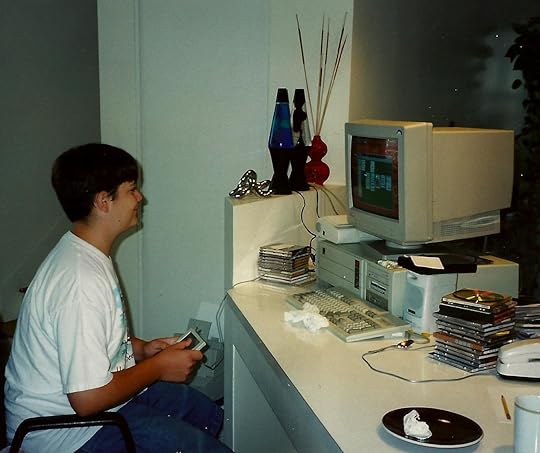
This is actually my cousin BJ’s computer, but if you thought I looked happy playing on his, imagine how excited I was to get one of my own.
I built my first website on GeoCities. I think it was /siliconvalley/hills/4924 (the Wayback Machine link only goes back to 1999 and by then I’d turned it into a MIDI collection website with some banner ads — I kind of hate myself for making this, but there you go). It was originally my fan page for Quake II (fun-fact: Masters of Doom was the book that made me fall in love with the idea of entrepreneurship). There wasn’t much going on there beyond some photos of rocket launchers and railguns with a few tacky animated flaming skulls. I really liked that game. But at the footer was a counter that showed how many people had viewed the website (I’d later learn that most of those “views” came from me reloading the page).
But at the time: what power! I could build something from my suburban bedroom and millions (okay, well, hundreds) of people all over the world could see just how much I loved a video game. That’s how I got interested in making websites. There was no turning back.

A company called Sidea was my first nonfamilial employer (I suspect the real reason my dad wanted a kid was that he needed someone to do all his yard work—and for well below minimum wage, I might add). I later worked a lot of random jobs between high school and college: Pizza Hut cook and waiter (some of the best customer-service experience one can get), deli counter attendant (I was terrible at this and hated smelling like cold cuts after work, despite how much my dog liked it), FedEx warehouse grunt (great exercise, though not very mentally stimulating), and parking booth attendant (get paid to read books? Yes, please! Until the robots replace humans, that is).
But the job with Sidea was one of the most pivotal I ever had–even if the company went bankrupt a year after I started (not my fault!), a victim of the dot-com bubble bursting.
My job was simple: I had to man a booth in the middle of a CompUSA store, armed with a headset microphone and a large computer monitor. I was to demo software and hardware every thirty minutes—regardless of whether or not anyone was listening. Want to give a fourteen-year-old experience in public speaking? Tell him he has to demo random computer products to an entire CompUSA full of people ignoring him.
I can’t tell you how many demos I gave to no one. But I did every one of them as though my boss were watching. In between demos, I killed time browsing the Internet for the latest in Quake II news. For this job I was paid a ludicrous ten dollars per hour. I think I know why Sidea went bust.
But damn if that wasn’t a fabulous way for me to start public speaking. If you’ve experienced the embarrassment of the public speaker’s worst-case scenario (speaking to a roomful of people who are both ignoring you and hating you) before you’ve finished puberty, things are probably going to be okay.
One day I was approached by a man trying to decide between two different mice. I don’t recall the details, but there wasn’t a big difference between them, save the color and maybe another minor feature. I pitched him on his two options with a quip about the bonus “feature” of a different color. He laughed and offered me a job. He handed me his card and said he’d like to hire me for sales. I kept that card in my wallet for years until it finally disintegrated. Fortunately, I scanned it before it did.

Thank you Carlos & Steve. You have no idea how much you did for me.
I didn’t have the heart to tell the man I was only fourteen. When I told my parents about the offer, they told me to finish high school first. I never called Steve Harper, general sales manager for Stanley Foods, Inc., but I had a hunch I was on the right track. I was always tall for my age, and weighing 260 pounds at the time also helped age me up, as much as being heavy may’ve sucked the rest of the time.
Being the tallest guy in the class and having a name that’s usually given to girls (in fact, I was named after a three-time title-winning boxer, Alexis Argüello) are enough to make a person stand out in school, but make him one of the most overweight as well and you’ve got a recipe for something. It easily could’ve gone the other way—self-loathing and depression—but I cared too much about video games and computers to realize how not cool I was.

Pure swag.
I overcame my weight by making jokes about it before bullies could. Girls were trickier, though. I nearly failed geometry because of a cute girl named Erin, who told me (well, she told my best friend, but so it goes in eighth grade) that I was too fat to go to the dance with.
Like a lot of my not-popular-but-not-pariah peers, we developed personalities and pursued hobbies that interested us, because “just being cute” wasn’t an option.
We tinkered on our computers and spent way too much time playing video games with each other. I started a nonprofit called FreeAsABird.org (I’m really regretting the WaybackMachine) that built free custom websites for small nonprofits that had little or no web presence. I e-mailed all my clients cold, and as far as I know they had no idea I was a teenager. After earning a 4.0 my freshman year, I did as little work as I could but still kept my grades up in high school so I could maximize my time spent gaming and running the competitive gaming teams I managed.
Thank goodness, too. Because that was a long-term investment in myself. Most schoolwork felt awfully irrelevant when compared to work that was actually affecting real people and giving me leadership opportunities (albeit digital ones), nurturing the community management skills that would come in handy later.
Of course, all that time in front of a monitor began to take its toll, as my metabolism wasn’t nearly as fast as my buddies’. Our fast-food binges may’ve done nothing but fuel LAN parties (that’s where lots of people bring their computers over to someone’s house to connect directly to a local area network—for gaming). True story: I’d never attended a party that didn’t have “LAN” in its name until college.
This pattern of eating wasn’t healthy. I got tired of being fat by my junior year of high school and decided to do something about it so I could get in good enough shape to play football before I graduated.
Thanks to regular exercise and the abolition of soda and junk food, I lost fifty-nine pounds. My pediatrician (who was always kind of a jerk) couldn’t believe it when he read it on the chart. And to this day I can’t believe how differently people treat me. To have been the “pear-shaped fat kid” for all those formative years and then join the ranks of the easy-on-the-eyes crowd is like turning on another life cheat code. One random night, I bumped into Erin (remember—from eighth grade?) at a movie theater—she literally didn’t recognize me. It felt great. I may have danced a jig when I got back to my seat to breathlessly tell my friends what had just happened.
There Are Nerds in College
I applied to only one college, the University of Virginia. At the time I didn’t give it much thought, but I can’t help wondering how much different life would’ve been if I hadn’t made that seemingly insignificant decision. I had no contingency plan aside from the local community college, much to my parents’ dismay. I included along with my application a CD-R with my “digital portfolio” on it. It’s rather embarrassing, but I’ve now uploaded it for your viewing pleasure. I’ll wait while you go look.
If you were drinking a cup of coffee at the time, I imagine you did a spit-take. If not, please don’t tell me, as I’d like to preserve the image.
Much to my parents’ relief, I got in to UVA. But that’s not the important part. The decision that defined my experience there and made reddit possible was checking the box for “old dorms” on the housing questionnaire. I didn’t know what this meant at the time; old dorms just sounded cooler than new dorms, which were really suites—I wanted something that looked like the colleges I’d seen in movies.
The day we moved in, I spotted a blond-haired guy playing Gran Turismo on his PlayStation 2 across the hall from my new dorm room. His name was Steve Huffman. I was thrilled because I’d worried that no one played video games in college—that this was something I’d have to leave behind as a relic of my childhood. Steve was much less excited to meet me, because he’d seen my name on the door and thought he was living on a co-ed hall. So I was excited that he played video games; he was bummed that I wasn’t a girl. He got over that, and we became best friends. Picking old dorms and ending up across the hall from Steve was one of the best, albeit most random, things that ever happened to me.
You’ve Got to Be Willing to Disrupt (and Be Disrupted)
My dad has been a travel agent for more than thirty years. I distinctly remember dinner-table conversations around the time the Internet started to disrupt the travel industry. As a high school student with a particular interest in computers and technology, I was especially enthralled with all the buzz around the “dot-com bubble.”
Dad, on the other hand, was watching his commissions from airlines get cut all the way to zero. Travel agents used to make good money from bookings that now were going to OTAs (online travel agencies). Because of this disruptive technology, people were now booking their own flights and hotels, cutting out the middlemen—people like my dad.
Just a few years before, my dad decided to leave his position at a large agency to start his own small travel agency. A first-time entrepreneur, he was now facing a dramatic shift in the way his industry did business—and there was no stopping it. The Internet was changing the fundamental business models for the travel industry.
One night he came home from the office particularly frustrated. He’d just learned from a major airline that they, too, would finally be eliminating travel agent commissions altogether. After years of being gashed by these airlines, my father sent them a fax to articulate just how he felt as his business was being eroded.
“Fuck you.”
He doesn’t remember if he put a cover sheet on that fax, but I like to think he did.
Unlike people in other industries, he couldn’t call his lobbyist on K Street and ask him to get a law passed that would make sure all travel agents get a commission. He had to adapt his business model. And he did. To this day, he continues to operate with a focus on business and first-time travelers (usually boomers taking their first cruise). It’s not an enterprise I’ll be likely to take over, especially given hipmunk, but it’s one he and his employees will, I hope, continue to run for years to come.
But those dinner-table conversations made an impression on me. The Internet was a powerful tool, and I wanted to be sure I knew how to use it. The free market is ruthless. But it has to be. It’s up to us to make the most of it.
We must be opportunistic—when disruptions happen we need to identify the new business models and adapt, as my dad did. Or better, we need to be the ones doing the disrupting.
I knew I wanted to be a disrupter.
Sometimes You Just Have to Stand Up
My commercial law professor at the University of Virginia, Professor Wheeler, one day commented in class on the fact that I always volunteered to be the demo person in front of the class when he needed human props. He said how important it was to show up, to stand up—lauding my effort. I just thought it was fun to be that guy in a class of hungover undergrads. It wasn’t that I thought I might get better grades, but I figured I had two legs, so why the hell not get up and use them?
I’d never expected to give a TED talk, let alone at twenty-six years old, but then again I’d never expected to be in Mysore, India, which is where I was in October of 2009 as an attendee of TEDIndia, one of the yearly TED presentations that the organizers host all around the world.
A month or so before the conference I was included on a massive e-mail blast from Chris Anderson, curator of the TED Conference, that included this attention-grabbing nugget:
It is commonly said that TED attendees are every bit as remarkable as those appearing on stage. It happens to be true. That’s why at every conference we invite you to consider whether you have something to contribute to the program—and possibly later to the wider TED community, through the TED.com site.
So there at my laptop I raised my virtual hand—so to speak—and submitted a pitch for a three-minute talk to TED. These are the palate cleansers in between the more heady and often very emotional eighteen-minute TED talks. I figured I’d better get right to the pitch. Here’s what I wrote:
The tale of Mister Splashy Pants: a lesson for nonprofits on the Internet. How Greenpeace took itself a little less seriously and helped start an Internet meme that actually got the Japanese government to call off that year’s humpback whaling expedition. People manage to sell entire books on the subject of “new media marketing” but I only need three minutes—with the help of this whale—to explain the “secret.”
How could they resist a name like Mister Splashy Pants? Splashy to his friends.
I figured they must’ve been totally floored with awe, because I didn’t hear back for a month. Was this just their way of saying no? I was already in India at this point, so I sent a quick “ping” e-mail to see if I could get a yes or no.
“Congratulations. You did get accepted.”
Hot damn, I had twenty-four hours to write and rehearse a talk people practice for months…
Better turn on some South Park.
Thanks to VPN, I could watch South Park from south India. The episode was called “Whale Whores” (season 13, episode 11), and it satirized the Animal Planet documentary-style reality show called Whale Wars (oh, puns!), which features the Sea Shepherd Conservation Society, an organization that harasses Japanese whalers in an effort to protect marine life.
In the episode, after hordes of Japanese storm the Denver aquarium during Stan’s birthday and slaughter all the dolphins (am I really writing about South Park right now? I love this country), an enraged Stan implores his friends to join him in protecting the dolphins and whales, which the Japanese seem so intent on eradicating.
Stan’s friends are not interested until Stan joins the cast of Whale Wars, at which point Cartman and Kenny pretend to be whale-loving activists in order to milk some of the fame associated with the show. They volunteer, despite admitting earlier that they “don’t give two shits about stupid-ass whales.”
I grabbed a screen capture of Cartman, in a Save the Whales shirt, proclaiming his love of whales; Kenny is beside him, dolphin lover (sic) scrawled on his chest.

That image reminded me of what was then one of the biggest events on reddit—voting for the name for a humpback whale that Greenpeace was tracking. This event has since been eclipsed by other events, such as the “money bomb” donation of over half a million dollars to DonorsChoose.org or fund-raising for three-year-old Lucas Gonzalez, who needed a bone marrow transplant. But the story of Mister Splashy Pants was a special moment in reddit’s development and proved to be a prophetic tale of the power of social media: for an idea to truly become mainstream, it needs to go beyond the early adopters—in this case, whale lovers like Stan—and also include those who want to join the trend.
A lot of people rag on PowerPoint (often rightfully so). But in the right hands, this much-maligned communication tool can actually be incredibly entertaining (and even informative). The problem is, most people don’t understand how to use it, which sets the bar for PowerPoint presentations really low. Here’s my philosophy: lots of big pictures, text, and tons of slides. For my TED talk, I had room for no more than a few words on each slide—and they had to be in 86-point type, minimum. Forty-two slides—a good sign, even though it meant I had only a little more than four seconds for each slide.
There was going to be a giant TED sign on the stage behind me. This could make or break my public speaking career. And I was going to be on the same stage where the brilliant statistician Hans Rosling, using beautiful data, emphatically demonstrated how India ascended to economic superpower status—meanwhile, I was going to talk about a whale named Mister Splashy Pants. No pressure.
I finished before sunrise and took a power nap. When I awoke I began feverishly practicing with my timer. I missed all the morning talks. I was terrified of Chris Anderson, who famously cuts off speakers when they go on too long. As someone who routinely talks more than I should, I didn’t want my talk punctuated by a giant cane pulling me offstage.
I’d later learn that TED does not in fact use a giant cane.
I don’t remember the talk before mine, because I was so busy trying to remember what I was going to say.
Why are my hands shaking?
Chris Anderson introduced me as Alex. I hate being called Alex, but I smiled and took the stage, trying hard not to trip on the way. When you’ve grown up embracing your unisex name (okay, it’s predominantly a woman’s name here in the United States), it’s incredibly vexing to hear someone shorten it to the male version. I’m a dude named Alexis; please call me by my name. Now I was thinking about Alexis Argüello, the three-time world champion boxer my father named me after, and I wondered if he ever had the same issue growing up in Nicaragua—shit, I’m supposed to give a talk right now.
Remember, it can’t go worse than a giant room of CompUSA shoppers actively ignoring you.
That got me started. Get to it, Ohanian.
“There are a lot of ‘Web 2.0 consultants’ [I made air quotes with my fingers] who make a lot of money—in fact, they make their livings on this kind of stuff. I’m going to try and save you all the time and all the money and go through it in the next three minutes, so bear with me.”
I breathlessly shared the story of Greenpeace’s dogged efforts to raise online awareness of their effort to stop Japanese humpback whaling expeditions. They wanted to track one particular whale on its migration and humanize it with a name chosen by their online community. Greenpeace staff chose about twenty very erudite names—like Talei and Kaimana (which means “divine power of the ocean” in a Polynesian language)— and then there was Mister. Splashy. Pants.
I enunciated each word one at a time for full comedic effect. Laughter. They’re not hating this.
Once a reddit user discovered the poll and submitted it to reddit.com, a surge of votes flooded in for this obvious favorite. Who doesn’t want to hear a news anchor say “Mister Splashy Pants”?
Greenpeace wasn’t pleased. They insisted on rerunning the voting process, which only galvanized us. I changed our reddit logo from a smiling whale to a more combative version.
For any scientists reading this:

This time, polls closed with Splashy having an even more commanding lead.
Oh no, I’m running out of time. Please let them be gentle.
Eventually they relented and let the online favorite win (sometimes you just have to let yourself be disrupted, remember), but at this point they’d inadvertently created a brand that excited far more people than just Greenpeace fans—the message had spread far beyond whale lovers. In fact, the Japanese government actually called off the whaling expedition.
Everyone who creates something online has lost control of their message but in the process has gained access to a global audience. Mister Splashy Pants is a story about the democratization of content online—starring a whale—and it demonstrated how little control we have over our brands. It turns out we never had control, only now we realize it. Before the social web, we had little idea of what people actually thought about us—now we know, and when like-minded people band together, they wield a really big stick.
The talk is over. Applause. Even a few “Woo!”s from the crowd.
Nailed it. I’d given a few non-CompUSA talks before then, but once the video of my TED talk hit a million views and was front-paged on reddit, I became a known “public speaker.” In a brilliant illustration of my argument, the video was submitted to reddit with the following headline: “Nutjob mistakenly allowed to give TED Talk, he rambles for over four minutes before being carried off the stage.”
I have a lecture agent now and get paid more for a speaking gig than I did for an entire year’s work at Pizza Hut. It’s a little bit insane, but then I remember that I’m still getting paid less than Snooki1, which makes me really question things.
I still get nervous before I get onstage—I just know how to better handle the nerves now. In truth, it really is all about practice. Once you’ve been onstage enough times and make sure you’re always well rehearsed and armed with the feeling that you really know what you’re talking about, it then becomes all about polish. Listen to yourself. I listen (not watch; I want to focus on the words) to every talk I give once afterward to see where the “ums” and “you knows” crept in. I’ll pay attention to jokes that didn’t work and others that worked better than expected—was it the joke or the delivery? Then I put that talk out of mind. Test, analyze, and repeat.
The Internet offers a wealth of great speeches, all freely available with just a few keystrokes. Find your favorite speakers and study them. I notice the way Jon Stewart disarms an interview subject with a joke before hitting him with a knockout punch. President Obama really knows how to hit the Pause button at the right moment for maximum impact. When used well, silence is powerful. And when I learned that Louis C.K.— easily one of the best comics of our generation—trashes all his material every year and starts anew, I knew I needed to keep from getting lazy and recycling entire talks. Louis does it because, he says, “The way to improve is to reject everything you’re doing. You have to create a void by destroying everything; you have to kill it. Or else you’ll tell the same fucking jokes every night.”
Being a stand-up comic is infinitely harder than giving a talk or a speech, so if he can stay that on top of his game, why can’t I?
There Are Much Harder Things in Life Than Being an Entrepreneur
Growing up, I had the words “lives remaining: 0″ written on the wall of my room. If life were a video game, that’s how it’d indicate this is the only chance left.
I’m lucky because I got that lesson when I was twenty-two years old and just a month or so out of college, feeling about as immortal as someone could.
But then everything changed with a phone call.
Why’s Mom calling me? She should be getting ready for her vacation trip to Norway.
She’s crying.
Max, our wonderful mutt, had to be put down.
Because I’m an only child, Max became my mother’s favorite when I left home for college—a position in her heart I could never reclaim. She absolutely adored him, and our family did everything we could to help him fight the Cushing’s disease that had finally taken its toll.
My mother was understandably distraught. I told her I loved her. I understood why she had to do what she did to our beloved dog and, although it didn’t work out that I could be there, I was grateful that she was. She had some more errands to run before meeting up with Dad and heading to the airport. She’d try to get through them the best she could, but I knew it was going to be hard for her to go on vacation.
At least it happened before she got on the plane.
My dog had just died. It was going to be a rough day in Boston. Startup life is extreme enough—every morning one wakes up thinking today’s the day you’re conquering the world—or today’s the day you’re doomed.
I got through that awful morning. I don’t remember what I was doing at the time, but my phone started buzzing again in the late afternoon.
Why’s Dad calling me? He should be at cruising altitude with Mom.
They’re in the hospital.
Howard County General.
On any other night Mom would be working there; she’d been a pharmacy technician there on the night shift for the last seventeen years.
Now she was missing the vacation she and my dad had planned for years.
She’d had a seizure in the dressing room of a department store, and an attentive clerk had called 911.
At least it happened before she got on the plane.
The initial brain scans revealed a tumor. The culprit in her skull was an insidious monster called glioblastoma multiforme. Such an ugly name. They were going to keep her overnight for more tests. She’d likely have surgery soon thereafter. I never should have done the Google search, but I needed to know what my parents would inevitably struggle to tell me.
I bought a ticket for a flight down first thing the next morning, but until then I was stuck in Boston. That night Steve and I tried to get our minds off things and went down to a local bar to watch our favorite team play their archrivals on Monday Night Football. Our Washington Redskins versus the Dallas Cowboys.
It was a really boring game. And we were losing it. So much for even a brief respite from the shittiest day of my life.
By the fourth quarter, there weren’t many TVs with the game still on (we were in Boston, after all). Back in Columbia, Maryland, my dad had already called it a night. He didn’t need any more heartache.
Steve and I had nowhere else to go and needed distraction—any distraction—so we kept watching. It was fourth and fifteen, and we were down 13–0 with less than four minutes left (non–football fans: just know that this means an exceptionally dire situation). Just then, Mark Brunell, a quarterback not known for his arm strength, hurled the ball downfield more than fifty yards to Santana Moss in the end zone.
It was 13–6!
But no one on the field was celebrating—and with good reason. There was hardly any time left, and we were still losing. Even the Cowboys’ mascot was taunting us with a dramatic look at his wrist to remind us that there wasn’t enough time left for our touchdown to matter.
But Steve and I kept cheering. What the hell. They had finally given us something to cheer about. That was our first touchdown of the season! And we’d been drinking, which always helps. We made the extra point, and it was almost a ball game. But that jerk in the Cowboys costume had a point.
Dallas ended up punting quickly, thanks to a stingy Skins defense, and we had the ball again (football novices: that’s our time to go on offense and score points).
First and ten from our own thirty-yard line. One of the commentators, John Madden, couldn’t even finish his run-on sentence before Brunell threw the exact same pass fifty-plus yards down the field right back to Moss, who again beat the coverage.
“And Santana Moss for a touchdown! Wow!” Al Michaels couldn’t believe his eyes as Moss hustled into the end zone.
At this point Steve and I were screaming. We were also the only two people still watching the game, I think.
Suddenly it was 14–13 and we were winning.
Winning? What?
Even when all hope seemed lost—see what happened there—we had to keep hoping, because that was all we had. As much as I wish I could affect the outcome of sporting events from my seat, there’s nothing I can do but cheer at the right times.
But it wasn’t over. Life isn’t a storybook. And what happened next is going to be exceptionally difficult to describe for non–football fans.
The Cowboys weren’t about to be upset so spectacularly in their own house on national TV. They briskly marched down the field, nearing field-goal range as the time kept ticking down. They didn’t need to reach the end zone; they needed to get just thirty-five yards or so from it. As long as they could kick a field goal, they could walk off the field as victors and dash our hopes.
They were that close, but only for a second.
A third-down completion to Patrick Crayton secured a first down and also put the Cowboys in field-goal range. Crayton got a step beyond the marker and then…contact.
BOOM!
You could hear the pop on the television broadcast. Sean Taylor, a lean and hungry safety, delivered a brutal—and legal—tackle that popped the ball loose, resulting in an incomplete pass.
BOOM!
I started yelling. Spilling beer. Probably also spitting a little. It was obnoxious because they kept replaying that hit and I kept yelling BOOM! louder with every replay.
Steve was yelling, too. Everyone else in the bar was hating us. We didn’t give a damn.
Later, I got my hands on the high-def footage of Taylor during and after that hit. He pops up, electrified. That fire. That heart. It’s something awesome when you watch a human—just another carbon-based life-form— doing what he does so well. And loving it.
That hit took all the air out of Cowboys Stadium, from the fans to the field. The Cowboys turned the ball over on downs, and Redskins players poured Gatorade on Coach Gibbs. Not a typical week-two celebration, but we thought it was appropriate.
Steve and I went home singing our fight song, and I had the joy of surprising my dad with the news the next morning. He’d never walked out on a game before and never would again.
I don’t believe in signs, mostly because I don’t think I’m worth all the trouble. But I was inspired.
Sean Taylor saved the day that night, doing what he loved and doing what he was so clearly talented at. It gave me a little bit of happiness on the saddest night of my life and confirmed that it’s never over until it’s over.
So I’d better not give up. And if I can find something I’m good at and love doing, I’m going to put everything I have into it.
Sean Taylor died two years later. He was shot by an intruder while at home with his girlfriend and daughter. He was twenty-four; just a few weeks older than I was at the time.
We often use words like bipolar and all-consuming to describe startup life. Fools compare it to combat, and over drinks even the more reasonable among us still veer into hyperbole about how hard it is to face the day some mornings. I’ve never lain in bed in self-pity, though. Even after that night I didn’t, because I knew back in Maryland my mother and father were dealing with a very different kind of morning. Perspective. My mom, the kindest person on earth, had been told she would die before seeing her grandchildren, and yet the first words out of her mouth when she saw me were “I’m sorry.”
That’s the kind of person she was. I knew I’d lived a rather stress-free life until that point, and I knew that that would have to change. I just didn’t think it’d happen all at once. My mom came to this country when she was twenty-three because she was in love with my dad. After a few years of living together while she was still an undocumented alien, they secretly married at City Hall in lower Manhattan, and only later did they have the “public” wedding for their families (surprise, Grandpa!). Eventually the cost of trying to raise a child in New York City (even in the boroughs—Brooklyn and then Queens) proved to be too much, and my parents moved to the suburbs of Maryland, where my dad’s modest income could go much further.
My father had a degree in urban studies and architecture from Antioch College, and my mother wound up getting her GED in 1980, just three years before I was born. She went on to work night shifts as a pharmacy technician, sleeping only a little so she could be present for more of my waking hours.
After all that, my mother—who had supported me my entire life, filled me with confidence, and loved me dearly—was telling me she was sorry she’d inconvenienced me by getting terminal brain cancer because it was something else I’d have to deal with?
Being an entrepreneur was the best decision I could’ve made, because not having a boss gave me the freedom to make my family a priority without compromising my work. I got a lot of use out of that 3G USB stick and laptop. As long as I had those two things, I was in the office, whether it was bedside at Hopkins or in the reddit headquarters in Somerville.
I write this all as a precursor to my story—to hell with chronological order—because as empowering as the Internet is (and boy, is it empowering), we must all still succumb to a common mortality.2 I would trade anything to have my mom back, but in lieu of that, I can only work to honor her a little bit more every day.
To be reading this book, thinking about how to use this great platform, the Internet, to share your world-changing ideas, ideally from a comfortable seat somewhere, is itself a great luxury. We’re living in a time of unprecedented opportunity across the globe that happens to coincide with a time of tremendous misfortune.
Let’s make the most out of this great hand we’ve been dealt, eh?

Ask Me Anything!
That’s the end of my first post on this blog. Round two is coming soon. But in the meantime…
You may have heard about a little thing we do on reddit called an “AMA” (Ask Me Anything). Tim did one a little while back that went quite well, watch his answers here. Now I’d like to open up my brain to all of you here in the comments section of this post. Ask me anything between 9am-1pm PST (12pm-4pm EST) here in the comments section and I’ll answer you — promise!
###
Large parts of this post were adapted from Alexis’ book: Without Their Permission: How the 21st Century Will Be Made, Not Managed.
About the author:
Alexis Ohanian is a startup guy making the world suck less: reddit, breadpig, hipmunk, Y Combinator. Investor, speaker, host of Small Empires, and loves his cat Karma.
This is a cultural reference from the early twenty-first century. Readers in the mid-twenty-first century and beyond will probably know her as President Snooki. I mean no disrespect.Except for the sentient robots. They’re going to be fine. Don’t shed a tear for them, because they wouldn’t for you—and they can’t; that’d be a lot of needless engineering.






September 16, 2013
Going From Wantrepreneur to Entrepreneur — A Challenge
This week will be Entrepreneurship Week on this blog.
To start us off, this post is a benevolent kick in the ass. I’ll preface the kick with something I wrote in The 4-Hour Workweek:
For all of the most important things, the timing always sucks. Waiting for a good time to quit your job? The stars will never align and the traffic lights of life will never all be green at the same time. The universe doesn’t conspire against you, but it doesn’t go out of its way to line up the pins either. Conditions are never perfect. “Someday” is a disease that will take your dreams to the grave with you. Pro and con lists are just as bad. If it’s important to you and you want to do it “eventually,” just do it and correct course along the way.
But talk is cheap, isn’t it? That’s the whole point, so let’s get to the action.
###
In 2009, Tobias Lutke, CEO of Shopify, and I developed the Build-A-Business Competition to transform would-be entrepreneurs into real entrepreneurs. Now in its 4th year, the competition has created more than 15,000 businesses that have sold more than $60 million in product (!).
Several readers of this blog — first-time business owners — have ended up generating millions of dollars each… some as side gigs to their full-time jobs! A few examples generated $250,000+ per month.
You don’t need need experience, and you don’t need a bunch of money. You just need to take the leap: join the competition, decide on your product category, listen to advice from mentors and fellow competitors, and sell the hell out of your product. That’s it.
“Whatever you can do, or dream you can, begin it. Boldness has genius, power and magic in it.”
- Johan Wolfgang von Goethe
Intangible products can also be sold in the competition, including digital downloads, services, and subscriptions. Make sure you check out the Shopify App Store (apps.shopify.com) for tons of great plugins.
This year’s competition is in partnership with Huffington Post, so there will be even more PR and exposure. Past participants have been featured in everything from Fast Company to The New York Times.
Who are your mentors? These killers, thrillers, and 100-dollar billers:
** Arianna Huffington (The Huffington Post)
** Mark Cuban (Dallas Mavericks, Shark Tank)
** Daymond John (FUBU, Shark Tank)
** Chase Jarvis (Photographer, Director)
** Tina Eisenberg (Swissmiss, CreativeMornings)
** Gary Vaynerchuk (Wine Library, Vaynermedia)
** Selita Ebanks (Victoria’s Secret Angel, Cause Marketer)
** Lil’ Jon (DJ & Producer)
** Amber Mac (TV Host, Author)
** Tim Ferriss (Angel Investor, Bearclaw Eater, Author: The 4-Hour Workweek)
The Build-A-Business competition runs from October 1, 2013 to May 31, 2014, with each of the mentors providing exclusive advice and guidance along the way. In addition to $50,000 cash prizes, the nine competition winners will receive an expenses-paid VIP trip for two to New York City to meet their mentors. It’s one hell of a party. The competition is open to people in the US, Canada, UK, Australia, and New Zealand.
Click here for full details.
Time to explore entrepreneurship, don’t you think? If not now, when? What’s stopping you? Let us know in the comments, and maybe we (including other readers) can help.
###
Odds and Ends Elsewhere:
4-Hour Chef for Whaaaa?!?:
$35 retail for less than $15? Yes, my friends. New coupon–get an additional $5 off the full-color hardcover of The 4-Hour Chef. Here it is.






September 10, 2013
The BitTorrent Strikes Back: The 4-Hour Chef Audiobook Goes Loose
As a thank-you to all of you today, I am today releasing the audiobook of The 4-Hour Chef…for free.
This includes almost 10 hours of recording: all of the chapters on accelerated learning, all of the ridiculous experiments and related stories, and much more.
I’m partnering with BitTorrent again to bring you a bundle of goodies. The full unlocked bundle for this release is 5.4 GB of free content (!), whereas my first BitTorrent release for the print edition was 187 MB. HD instructional videos? Bonus PDFs? You got it.
The audiobook also features guest narration from one of my heroes–bestselling author Neil Gaiman!
I’ve written about Neil before (read my gushing here), and if you’re not a fan yet, you will be. Special thanks to Neil, his amazing assistant Cat, and also to Max Adams, who acted as Twitter matchmaker:
@CelluloidBlonde tell @tferriss that I’m in.
— Neil Gaiman (@neilhimself) January 27, 2013
I hope you enjoy the audiobook as much as I enjoyed producing it. Here’s the announcement and download links from BitTorrent…
The 4-Hour Chef: Accelerating Learning for Free
What’s the value of a free read?
Last November, we partnered with best-selling author Tim Ferriss to find out. We handed out sections and drafts from his new book, The 4-Hour Chef, to BitTorrent fans. In turn, 880 thousand of them checked out the hardcover on Amazon. And 2012′s boycotted book about meta-learning hit 2013’s bestseller lists, from the New York Times to the Wall Street Journal.
A free read, it turns out, is a powerful thing.
So, what’s a listen worth?
We’re letting the people decide. Today, Tim Ferriss is giving away the full audiobook of The 4-Hour Chef, complete with six hours of HD creativeLIVE tutorials that bring the 4-Hour lessons to life. Call it an experiment in anti-cannibalization. Our goal is to see how different formats can feed off of, and feed, one another.
Here’s the deal:
Check out Tim Ferriss’s page on BitTorrent. You can instantly download several chapters of The 4-Hour Chef audio, Part 1 of the full-color ebook (62 pages), and three workshop videos from creativeLIVE.
Subscribe to the book’s email list, and unlock the full audiobook narrated by Ferriss, Neil Gaiman, and Adam Verner, plus ten additional workshop videos. It’s everything you need to master everything, basically: from the kitchen to the basketball court. Except the hardcover. (You’ll need to go here for that.)
Download The 4-Hour Chef Bundle
Instant Download:
The 4-Hour Chef: eBook Part 1 [PDF]
The 4-Hour Chef: AudioBook Introduction [Audio]
The 4-Hour Chef: creativeLIVE Workshop, Day 1 [3 Videos]
Unlocked Bundle
The 4-Hour Chef: Full AudioBook [Audio]
The 4-Hour Chef: Creative Live Workshop, Day 2 [9 Videos]
###
Also Tonight (9/10) from 6-7pm PT (9-10pm ET)…
I’ll be doing a live Q&A on Twitter for 60 minutes. Ask me anything. Really. To make my day, download the audiobook first and let me know what you think! Here’s how it works:
1) Follow @merrelloutside. I’m partnering with them for this, so you’ll need to follow them to see my responses to questions.
2) Ask questions in the following format:
“@tferriss @merrelloutside [insert question]? #asktim”
3) I’ll answer ‘em as fast as I can! Hope to see you tonight.






September 7, 2013
An Ideal Day (or Weekend) in San Francisco – 16 Fun and Weird Activities
San Francisco is my favorite city in the world, bar none.
I love NYC, I love Bali, and I love Buenos Aires, but SF is the place for me. And since I’ve been here for 10+ years, I get asked a lot: what should I do when I visit?
This post will highlight some of my favorite things.
Recently, I joined forces with InsideHook – the “essential lifestyle guide for adventurous and discerning men.” I’ll be their SF curator (and advisor), helping them find and share hidden gems in gadgets, food, outdoor adventure, and more. Subscribers get one hand-picked item per day via email. That’s it.
I encourage you to check it out here. At the very least, you’ll get an education in headlines, as their copywriters are amazing.
Now — onward!
Below is one of my ideal days in SF, planned out so everything is within close walking distance.
A Damn Fine Day
Wellness FX Blood Analysis
Activity: Blood-drawing and high-end diagnostics
Description: Visit one of Wellness FX’s labs for a blood drawing to produce an in-depth analysis of your state of health. Results offer a wide range of information, from cholesterol and hormone levels the to an analysis of your body’s electrolytes and vitamins.
Pricing: $29-$529+

SideWalk Juice
Activity: Smoothies, juice blends and more at 21st/Valencia.
Description: SideWalk provides made-to-order juices, smoothies & kombucha juice blends that are as delicious as they are beneficial to your physical and mental health. My favorites? The “Green Machine” and the “Jake Shields,” named after the local UFC fighter (“The strongest kale drink in existence!”).
Pricing: $4.25-$7.00

Street Art Tour
Activity: Walking tour of two alleyways with notable graffiti artwork with Dan Pan. We focused on the Mission district.
Description: Guided walking tour with Dan Pan, founder of 1AM Gallery’s new street-art app. The app allows you to find nearby street art, as well as take pics and have users tell you the artist (very cool). Try Clarion Alley as a starting point, which is run by an artists’ collective.
Pricing: The 1AM app is free.
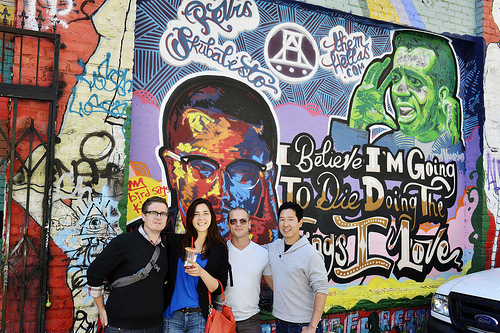
Mission Cliffs Climbing
Activity: Indoor rock climbing
Description: Indoor rock climbing at Mission Cliffs, a sprawling gym located at 2295 Harrison St.
Pricing: $20-$160
Lunch at Salumeria
Activity: Lunch at Salumeria
Description: Salumeria is a 20th St. deli and larder that marries the culinary traditions of Old World Italy with the trend-hopping foodie culture of contemporary San Francisco.
Pricing: $6-$17
Drinking!
Activity: Adult beverages with friends
Description: Enjoying social lubrication with new or old friends. A fine tradition as old as time. Some of my favorite spots include:
St. Vincent (Mission)
Hotel Biron (Downtown-ish, Hayes Valley)
Trick Dog (Mission; Disclosure: I’m an investor)
Bourbon and Branch (Tenderloin)
Pricing: Varies.
4 More Free Activities
Hawk Hill: where you can take a bike ride into our Cold War past.
Once upon a time, Fortress America dotted San Francisco’s hilltops with Nike missiles and radar outposts. Of course, those missiles were never fired — but you can still visit the rusted remnants of their vigilance if you bike up to the SF-87C radar outpost, the best-kept secret of the Marin Headlands coastline.
The Lands End Trail, where you’ll find the best maze in the Bay.
Truck up the Great Highway to stretch legs and strut your knowledge of the Sutro Baths. Hike up the Land’s End Trail from the ruins to the labyrinth at Eagle’s Point. It’s only a couple miles round trip, and damn fine panoramic views’ll be in serious supply.
California Cheese Trail: pairs well with Mission Cheese (below) or your vineyard of choice.
As an adult, your knowledge on cheese should surpass the realms of Lunchables and Easy Mac. Showing you the whey: the California Cheese Trail app from the folks at the Marin Agricultural Land Trust, available now for iPhone and Android. If you’re up for spending a few bucks on cheesy delights, visit Mission Cheese on Valencia.
The Bay Bridge’s long-awaited East Span.
The opening of the Bay Bridge’s new East Span has been years in the making, and now it’s officially open, welcoming pedestrians and cyclists of all stripes and offering exclusive access to Yerba Buena Island.
6 More Paid Activities
Vantigo: Tour beer breweries in a cherry-red VW Bus.
Indulge your nostalgia for simpler days with Vantigo, now offering tours of some of the Bay Area’s best microbreweries via a pristine ’71 VW Vanagon.
Pricing: $85 per person
Trumaker and Co.: Shirtmakers who come to you.
Restock your shirt library with Trumaker and Co., a custom shirtmaker with a highly mobile fleet of outfitters. It’s simple: you make an appointment, they send a tailor your way.
Pricing: from $98, free outfitter appointment
Boatbound. Because every man should own a boat…if only for a day.
Herein: your guide to using BoatBound, a new AirBnB-style boat rental service. SF Bay or Half Moon Bay?
Pricing: from $250 per day
Big Sur Roadhouse. The Big Sur getaway you’ve been looking for.
There’s a sprawling new Cajun restaurant in Big Sur. There are also some skinny-dip-friendly hot springs down the road. That gives you at least two good excuses to visit.
Pricing: from $50 per person
Mikkeller. It’s like a beer tour of Europe in a single bar.
The legend of Danish brewery Mikkeller has been growing across the pond for some time; they just opened their first North American alehouse in San Francisco.
Pricing: varies
Shelter Co.: Romantic private camping service with tent butlers.
Shelter Co. offers completely customized luxury camping experiences. You want tent butlers? They got tent butlers. You want a private island? They will rent you a private island.
Pricing: from $2000
Let’s Talk About This…
Want more activities, rare finds, and goodies? Sign up for InsideHook and let me know what you think. I’ll also choose one person who signs up for a 30-minute phone call with me.
Then what? How about you try my Pacific Northwest roadtrip from SF to Whistler? Damn, I love the Bay Area.
What’s your favorite city in the world, and what are your favorite 2-4 activities?
###
Related Posts:
How to Live Like a Rock Star in Buenos Aires
How to Hack Tokyo for Less Than NYC
How to Travel Through 20+ Countries with Free Room and Board
How to Travel to Exotic, Expensive Cities on $50 a Day (e.g. Paris, Hong Kong)










